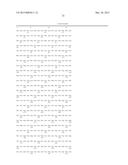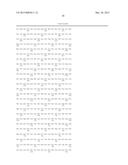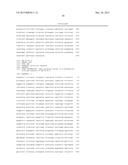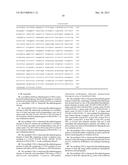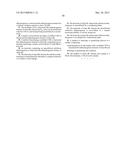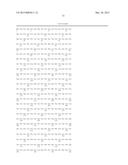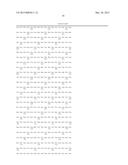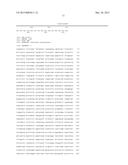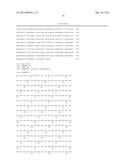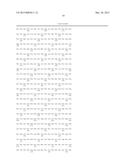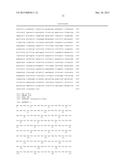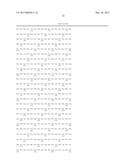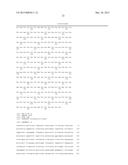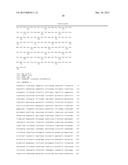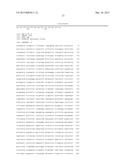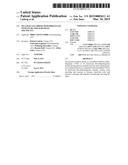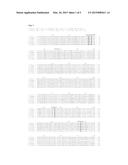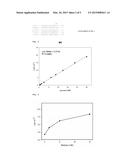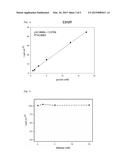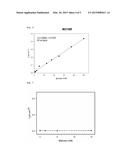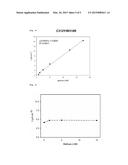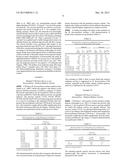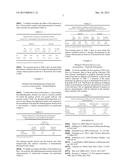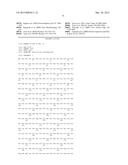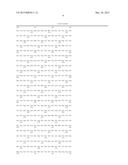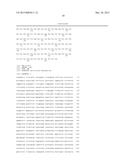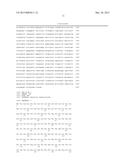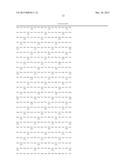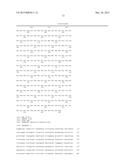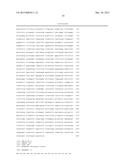Patent application title: Mutated Cellobiose Dehydrogenase with Increased Substrate Specificity
Inventors:
Roland Ludwig (Vienna, AT)
Christoph Sygmund (Klosterneuburg, AT)
Wolfgang Harreither (Vienna, AT)
Roman Kittl (Vienna, AT)
Alfons Felice (Vienna, AT)
IPC8 Class: AC12N904FI
USPC Class:
2057775
Class name: Electrolysis: processes, compositions used therein, and methods of preparing the compositions electrolytic analysis or testing (process and electrolyte composition) involving enzyme or micro-organism
Publication date: 2015-03-26
Patent application number: 20150083611
Abstract:
The present invention relates to a modified cellobiose dehydrogenase
(CDH) or its functional flavodehydrogenase domain having glucose
oxidation activity and a reduced maltose oxidation activity as compared
to the unmodified CDH or its functional flavodehydrogenase domain,
nucleic acids encoding said enzyme or domain, electrodes with said enzyme
or domain and methods of producing and using the same.Claims:
1.-15. (canceled)
16. A modified cellobiose dehydrogenase (CDH) or functional flavodehydrogenase domain having glucose oxidation activity and a reduced maltose oxidation activity as compared to an unmodified CDH or functional flavodehydrogenase domain.
17. The modified CDH or functional flavodehydrogenase domain of claim 16, wherein the modification is a modification of at least one amino acid corresponding to any one of amino acids 310-320, 342-347, 599-625 or 718-725 of the M. thermophilum cellobiose dehydrogenase of SEQ ID NO: 1, or any combination thereof.
18. The modified CDH or functional flavodehydrogenase domain of claim 17, wherein the modification is a modification of at least one amino acid corresponding to any one of amino acids C312, N313, W316, R622 and/or N721 of the M. thermophilum cellobiose dehydrogenase of SEQ ID NO: 1, or any combination thereof.
19. The modified CDH or functional flavodehydrogenase domain of claim 18, comprising at least a mutation corresponding to a C312Y, W316R, W316L, R622N, N721D mutation in SEQ ID NO: 1 or any combination thereof.
20. The modified CDH or functional flavodehydrogenase domain of claim 19, comprising a C312Y mutation in combination with either a W316L mutation or a W316R mutation.
21. The modified CDH or functional flavodehydrogenase domain of claim 16, said unmodified CDH being a CDH of Myriococcum thermophilum, Corynascus thermophilus, Chaetomium atrobrunneum, Hypoxylon haematostroma, Neurospora crassa or Stachybotrys bisby.
22. The modified CDH or functional flavodehydrogenase domain of claim 16, comprising a modified flavodehydrogenase domain based on one of the unmodified flavodehydrogenase domains of amino acids 251-828 of SEQ ID NO: 1, amino acids 263-839 of SEQ ID NO: 3, amino acids 253-831 of SEQ ID NO: 5, amino acids 249-787 of SEQ ID NO: 7, amino acids 251-829 of SEQ ID NO: 9, or amino acids 253-829 of SEQ ID NO: 11, said modified flavodehydrogenase domain having a sequence with at least 50%, at least 55%, at least 60%, at least 65%, at least 70%, at least 75%, at least 80%, at least 85%, at least 90%, at least 95%, at least 98%, or at least 99% sequence identity with one of said unmodified flavodehydrogenase domains and further comprises at least one amino acid modification reducing the maltose oxidation activity.
23. The modified CDH or functional flavodehydrogenase domain of claim 16, further comprising an amino acid modification increasing glucose oxidation activity.
24. The modified CDH or functional flavodehydrogenase domain of claim 16, being recombinantly produced by Pichia pastoris, isolated by diafiltration, ion exchange chromatography.
25. The modified CDH or functional flavodehydrogenase domain of claim 24, being further purified by hydrophobic interaction chromatography.
26. The modified CDH or functional flavodehydrogenase domain of claim 16, wherein the KM value of the cellobiose dehydrogenase or functional flavodehydrogenase domain for a maltose oxidation reaction is above 50 mM.
27. The modified CDH or functional flavodehydrogenase domain of claim 26, wherein the KM value can be determined with the CDH or said domain being immobilized on an electrode.
28. A nucleic acid molecule encoding a modified CDH or functional flavodehydrogenase domain of claim 16.
29. A method of producing a modified CDH or functional flavodehydrogenase domain of claim 16, comprising recombinantly expressing a nucleic acid molecule of claim 28 in a host cell.
30. An electrode comprising an immobilized cellobiose dehydrogenase or functional flavodehydrogenase domain of claim 16.
31. The electrode of claim 30, wherein the cellobiose dehydrogenase is immobilized by adsorption, complex formation, or covalent or ionic linkage.
32. The electrode of claim 31, wherein the cellobiose dehydrogenase is immobilized by a complexing linker.
33. The electrode of claim 30, wherein the immobilized cellobiose dehydrogenase is cross-linked in a manner increasing stability or activity during use.
34. The electrode of claim 31, wherein the cellobiose dehydrogenase is crosslinked by a bifunctional agent.
35. A method of detecting or quantifying glucose in a sample, comprising: oxidizing glucose in said sample with a modified CDH or functional flavodehydrogenase domain of claim 16; and detecting or quantifying said oxidation.
36. The method of claim 35, wherein said sample is a blood, blood plasma, or blood serum sample.
Description:
[0001] The field of the present invention relates to recombinant enzyme
modification to modify substrate specificity.
[0002] Cellobiose dehydrogenase (EC 1.1.99.18, CDH) was first discovered in 1974 in the extracellular enzyme system of Phanerochaete chrysosporium and later on in several other basidiomycetous fungi. Cloning and sequence analysis of CDHs are e.g. described in Zamocky et al., 2008. A special characteristic of this enzyme is its composition: the combination of a catalytically active flavodehydrogenase domain (also called "flavin domain"), hosting a non-covalently bound FAD, and a haem domain, with a haem b as a cofactor. Both domains are connected by a linker. By its catalytic activity the natural substrate cellobiose is oxidised in a reaction which reduces the FAD of the flavin domain.
[0003] CDH or its flavodehydrogenase domain oxidises carbohydrates like its natural substrates cellobiose and cello-oligosaccharides and others like lactose and maltose. CDHs have been discovered and modified previously to be capable of converting glucose efficiently (Harreither et al., 2011; WO 2010/097462 A; Sygmund et al., 2009).
[0004] It was shown recently that maltose present in blood can negatively affect the accuracy of the glucose determination by glucose dehydrogenase (having a pyrrolinoquinolone quinone cofactor) based glucose meters (in the web at www.fda.gov/BiologicsBloodVaccines/SafetyAvailability/ucm155099. htm). Increased maltose levels can occur after treatments with immune globulin products containing maltose, peritoneal dialysis solutions containing isodextrin (which is metabolised to maltose and other oligosaccharides) or maltose containing infusion solutions. To circumvent that problem, FAD-dependent glucose dehydrogenase was mutated to exhibit a higher substrate specificity for glucose (EP 1 739 174 A). CDHs tested for maltose conversion so far showed activity with this substrate (Zamocky et al., 2006).
[0005] It is a goal of the present invention to provide a cellobiose dehydrogenase or its catalytically active flavodehydrogenase domain, which is capable to selectively detect glucose in the presence of maltose, especially with direct electron transfer based electrodes or mediated electron transfer-based electrodes to provide suitable analytically useful sensors.
[0006] The present invention relates to recombinant modified cellobiose dehydrogenases (CDH) with reduced maltose turnover, alone, or in combination with an increased glucose turnover. The aim is to reduce the effect of any maltose concentration present in a sample matrix on glucose detection. Preferred modified cellobiose dehydrogenase enzymes of the invention are optimized for use in biosensors based on direct electron transfer (3rd generation) or based on mediated electron transfer (2nd generation).
[0007] To increase the performance of CDH as selective electrode catalyst for glucose, the reduction of maltose oxidation activity alone or in combination with an increase of glucose oxidation activity was pursued by genetic modification. With the general description of modifying a CDHs flavodehydrogenase domain, a domain of high homology in all CDHs, it is possible to modify any CDH according to the principles outlined herein in order to decrease maltose sensitivity. Thus the present invention provides a modified cellobiose dehydrogenase (CDH) or its functional flavodehydrogenase domain having glucose oxidation activity and a reduced maltose oxidation activity as compared to the unmodified CDH or its functional flavodehydrogenase domain. The invention further provides a method of oxidizing glucose with the CDH of the invention. Such a method is preferably used in the analytical detection of glucose in a sample.
[0008] Most CDHs are capable of oxidizing glucose. The oxidation reaction can be detected e.g. by monitoring electron acceptors for the redox reaction such quinones, like as DCIP (2,6-dichloroindophenol) o- or p-benzoquinone or derivatives thereof, methylene blue, methylene green, Meldola's blue, potassium ferricyanide, ferricenium hexafluorophosphate, FeCl3 or cytochrome c (the latter being a haem domain cofactor) or simply by determining electric current or voltages on an electrode, the electron acceptor being the electrode surface.
[0009] WO 2010/097462 A describes isolated CDHs and modifications of CDHs to increase glucose oxidation at a pH of 7.4. WO 2010/097462 A especially focuses on increasing the pH optimum and interaction between the flavin domain and the haem domain. Such CDHs are preferred starting CDHs for the present invention, but the invention is not limited to glucose oxidation activity at pH 7.4. Any pH is suitable for the present invention. Preferably the CDH of the invention has glucose oxidation activity at a pH of between 2 and 9, preferably between 3 and 8.5, especially preferred between 4 and 8, even more preferred between 5 and 7.5 or between 5.5 and 7. Furthermore it is not necessary to use an entire CDH; the flavin domain, even without the haem domain, is sufficient for catalytical activity. The domain is therefore referred to as "functional domain" as it has the function of oxidizing glucose with a suitable electron acceptor. The activity is excerted by either the whole enzyme cellobiose dehydrogenase or the catalytically active flavodehydrogenase domain.
[0010] Wild type CDHs have an undesirable activity to oxidize maltose. This modification according to the present invention should now be understood in that the inventive CDHs deviate from the wild-type CDHs by this substantially decreased maltose oxidation activity. This substantially decreased maltose oxidation activity may be in combination with an increased glucose oxidation activity.
[0011] Preferred modified CDHs or their functional flavodehydrogenase domain are of a CDH of Myriococcum thermophilum, Corynascus thermophilus, Chaetomium atrobrunneum, Hypoxylon haematostroma, Neurospora crassa or Stachybotrys bisby. Such unmodified CDHs are described in WO 2010/097462 A and in sequences of SEQ ID NO: 1, 3, 5, 7, 9 and 11 herein. "Unmodified" as used herein is a CDH without the inventive modification that decreases maltose oxidation activity or maltose sensitivity. There may be modifications that increase interaction between the favin and the haem domains if an entire CDH is used (such as described in WO 2010/097462).
[0012] The modified CDH or its functional flavodehydrogenase domain preferably comprises a modified flavodehydrogenase domain based on one of the unmodified flavodehydrogenase domains according to amino acids 251-828 of SEQ ID NO: 1, amino acids 263-839 of SEQ ID NO: 3, amino acids 253-831 of SEQ ID NO: 5, amino acids 249-787 of SEQ ID NO: 7, amino acids 251-829 of SEQ ID NO: 9, or amino acids 253-829 of SEQ ID NO: 11. Preferably the inventive modified flavodehydrogenase domain has a sequence with at least 50%, preferably at least 55%, at least 60%, at least 65%, at least 70%, at least 75%, at least 80%, at least 85%, at least 90%, at least 95%, at least 98%, in particular preferred at least 99%, sequence identity with one of said unmodified flavodehydrogenase domains and further comprises at least one amino acid modification reducing the maltose oxidation activity. Such an amino acid modification or mutation may be an amino acid substitution, deletion or addition. Homologous CDHs or flavodehydrogenase domains within these sequence requirements can be readily identified by sequence comparisons such as by sequence alignment using publicly available tools, such as BLASTP, ClustalW or FastDB. Preferably, a homologous or modified CDH or the domain thereof has 1, 2, 3, 4, 5, 6, 7, 8, 9, 10, at least 11, at last 13, at least 15, at least 17, at least 20, at least 25, at least 30, at least 40, at least 50, at least 60, at least 80, at least 100 and/or up to 100, up to 80, up to 60, up to 50, up to 40, up to 30, up to 30, up to 20, up to 15 amino acid substitutions, deletions, insertions or modifications, and any ranges between these values, as compared to any one of the CDHs of SEQ ID NOs 1, 3, 5, 7, 9 or 11 or any of their flavodehydrogenase domains.
[0013] Preferably the inventive CDH has at least 1, 2, 3, 4, 5, 6, 7, 8, 9 or 10 or more amino acid modifications to reduce maltose oxidation activity as can be determined by the assays described herein, such as by using DCIP as electron acceptor or on an electrode. Such amino acid modifications are usually in the catalytically active center of the flavin domain.
[0014] The inventive amino acid modifications are of amino acids responsible for the maltose binding and/or catalysis, especially modifications in the catalytic site involved in substrate interaction. A prediction of such modifications can be made by computational methods using e.g. molecular docking into crystal structures such as of PDB database entry "1 kdg".
[0015] The effect of modified amino acids in the active site and the substrate binding site can be determined for homogeneous catalysis by photometric methods and for heterogeneous catalysis by electrochemical measurements using enzyme electrodes as described herein.
[0016] The methods for the modification may be any known in the art such as amino acid mutations, including amino acid substitutions, deletions or additions but also chemical modification/derivatisation of amino acid side chains.
[0017] The inventive enzyme or domain is usually recombinantly expressed. Also provided are preparations comprising the modified CDH or domain. The term "enzyme" or "enzyme preparation" as used herein refers to a cellobiose dehydrogenase or its flavodehydrogenase domain from a specified organism which is at least about 20% pure, preferably at least about 40% pure, even more preferably at least about 60% pure, even more preferably at least 80% pure and most preferably at least 90% pure, as determined by polyacrylamide gel electrophoresis (SDS-PAGE).
[0018] The present invention relates to modified/genetically engineered cellobiose dehydrogenases from existing protein scaffolds, which oxidise maltose less efficiently with or without a more efficient glucose turnover than the currently known cellobiose dehydrogenases. The kinetic constants of the enzymes responsible for this effect are preferably a higher KM value and lower kcat value for maltose alone or in combination with a lower KM value and higher kcat value for glucose than the currently characterised enzymes.
[0019] Preferably the KM value of the cellobiose dehydrogenase or its functional flavodehydrogenase domain for a maltose oxidation reaction is above 50 mM, preferably as determined with the CDH or said domain being immobilized on an electrode. Of course, the modified CDH or the flavin domain has still activity for an electrocatalytic oxidation of glucose. Especially preferred the CDH or flavin domain has the property that a signal of maltose during glucose detection or glucose concentration determination is below 5%; particularly the signal, e.g. electrode current or electrochemical reduction of an electron acceptor, of 30 mM maltose in a solution comprising mM glucose solution is below 5%. In preferred embodiments of the invention the maltose oxidation activity of the CDH is reduced in relation to glucose oxidation activity. Especially preferred the concentration dependency of the maltose oxidation is reduced so that--if maltose is present--only a substantially constant contribution of maltose to the signal is detected in relation to a glucose signal.
[0020] It is understood that one of skill in the art may engineer the mentioned or other cellobiose dehydrogenases to obtain the modified CDH or the active flavodehydrogenase domain using the principles outlined herein like the rational enzyme engineering via site-directed mutagenesis or directed evolution approaches (e.g., gene shuffling, error-prone PCR, etc.) and subsequent screening of the generated diversity. The techniques to introduce a mutation into the nucleic acid sequence to exchange one nucleotide for another nucleotide with the aim to exchange one amino acid for another in the resulting protein may be accomplished by site-directed mutagenesis using any of the methods known in the art.
[0021] Preferred modifications (amino acid deletions, substitutions or additions) of the CDH of the flavodehyrogenase domain in order to decrease the activity of maltose oxidation, optionally together with an increase of glucose activity are preferably situated in the active site of CDH, which can be divided into the catalytic site (C-site) and substrate binding site (B-site) of the flavodehydrogenase domain (Hallberg et al., 2002). The active site is formed by the amino acids Phe 251 to Phe 283, Ala 284 to Leu 352 and Asp 611 to Ser 772 of the M. thermophilum CDH of SEQ ID NO: 1.
[0022] In especially preferred embodiments the modification of the modified CDH or its functional flavodehydrogenase domain is a modification of at least one amino acid corresponding to any one of amino acids 310-320, 342-347, 618-624 or 718-725, and most preferably of any one of amino acids 312, 313, 316, 622 and 721, of the M. thermophilum cellobiose dehydrogenase of SEQ ID NO: 1, or any combination thereof. The amino acids are closely located to maltose binding to the flavin domain or catalytic oxidation of maltose. Preferred amino acids for modification are thus amino acids corresponding to amino acids 310, 311, 312, 313, 314, 315, 316, 317, 318, 319, 320, 342, 343, 344, 345, 346, 347, 599, 600, 601, 602, 603, 604, 605, 606, 607, 608, 609, 610, 610, 611, 612, 613, 614, 615, 616, 617, 618, 619, 620, 621, 622, 623, 624, 625, 718, 719, 720, 721, 722, 723, 724, 725 or any combination thereof of the CDH of SEQ ID NO: 1.
[0023] Especially preferred amino acid residues involved in substrate binding in the B-site and suitable for modification are corresponding to C312, N313, W316 and R622 of SEQ ID NO: 1. Amino acid residues involved in substrate binding and substrate conversion in the C-site correspond to 5720, N721, H722, and N769 of SEQ ID NO: 1. The amino acids count starts from the initial Met residue of the pre-pro leader sequence, which is cleaved in the mature CDH. Corresponding amino acids are given in FIG. 1 herewith or FIG. 3 of WO2010/097462 A1 and can be determined by sequence comparison algorithms such as BLAST or Clustal (www.ebi.ac.uk/Tools/msa/clustalw2/). Corresponding amino acids are e.g. for the CDH of C. thermophilus: C310, N311, W314, R618, N718, Chaetomium attrobrunneum: C314, N315, W318, R624, N723, Hypoxylon haematostroma: C320, N321, W324, R638, N737, Neurospora crassa: C314, N315, W318, R623, N722 and Stachybotris bisbii: C312, N313, W316, R621, N721. Preferred Corynascus thermophilus modified amino acids are amino acids 309-318, 595-621 and 717-722, preferably of any one of amino acids 310, 311, 314, 618 and 718 of SEQ ID NO: 7, especially preferred a C314Y mutation in combination with either a W314L mutation or a W314R mutation.
[0024] The amino acid positions and modification to reduce maltose oxidation and/or increase glucose oxidation activity can be obtained by homology modeling using the crystal structure of Phanerochaete chrysosporium CDH (PDB database entry 1 kdg) as template and superimposition of the obtained models as well as docking studies. It is possible to use a CDH as template and by sequence comparison to obtain corresponding amino acids for modification to reduce maltose oxidation activity.
[0025] Possible modifications include (1) the exchange of small amino acids by bulkier ones to decrease the available space in the B-site of CDH for the bulkier and sterically demanding maltose molecule. Bulkiness correlates with molecular mass of the amino acids. Amino acids can be made bulkier by exchanging to the following amino acids beginning with the highest molecular mass: tryptophan>tyrosine>arginine>phenylalanine>histidine>methi- onine>glutamic acid>lysine>glutamine. These substituents are preferred modifications for all positions as identified, especially for amino acid corresponding to any one of amino acids 310-320, 342-347 or 599-625 of the M. thermophilum cellobiose dehydrogenase of SEQ ID NO: 1. Modifications in this order are especially preferred for positions corresponding to C312, N313 and/or N721 of SEQ ID NO: 1. 2) The exchange of amino acids forming stabilising interactions with the second glucose moiety of maltose in the B-site into amino acids exerting no or detrimental interactions and increase the KM value of maltose. E.g. amino acids corresponding to W316 and/or R622 of SEQ ID NO: 1 or further B-site amino acids as mentioned above, especially under (1), can be changed into alanine, valine, leucine, isoleucine, asparagine, glutamine or arginine. By such modifications also the binding of glucose in the B-site is weakened, which favours further transport to the C-site and the formation of the transition complex. 3) The exchange of the tryptophan residue corresponding to W316 in SEQ ID NO: 1 close to the second glucose moiety at the B-site by arginine, lysine, leucine or isoleucine to decrease the affinity of maltose.
[0026] Particularly preferred is a modification of at least one amino acid corresponding to any one of amino acids C312, N313, W316, R622 and/or N721 of the M. thermophilum cellobiose dehydrogenase of SEQ ID NO: 1, or any combination thereof.
[0027] An especially preferred modified CDH or its functional flavodehydrogenase domain, comprises at least a mutation corresponding to a C312Y, W316R, W316L, R622N, N721D mutation in SEQ ID NO: 1 or any combination thereof, preferably a C312Y mutation in combination with either a W316L mutation or a W316R mutation.
[0028] The modified CDH or its functional flavodehydrogenase domain may further comprise an amino acid modification increasing glucose oxidation activity. Several of the above mentioned modifications also achieve this goal.
[0029] The modified CDH or its functional flavodehydrogenase domain may be isolated by diafiltration, ion exchange chromatography and preferably being further purified by hydrophobic interaction chromatography. Preferably the CDH or the domain is recombinantly produced by Pichia pastoris.
[0030] The invention further provides a nucleic acid molecule encoding a modified CDH or its functional flavodehydrogenase domain as described above. Such nucleic acids are e.g. given in SEQ ID NOs. 2, 4, 6, 8, 10, 12 and 13. The inventive nucleic acid molecule encoding a cellobiose dehydrogenase having reduced maltose oxidation activity may comprise a nucleotide sequence of SEQ ID NOs 2, 4, 6, 8, 10, 12, or 13; or the open reading frame of SEQ ID NOs 2, 4, 6, 8, 10, 12, or 13; or a nucleotide sequence with at least 50%, preferably at least 55%, at least 60%, at least 65%, at least 70%, at least 75%, at least 80%, at least 85%, at least 90%, at least 95%, at least 98%, in particular preferred at least 99%, identity to SEQ ID NOs 2, 4, 6, 8, 10, 12, or 13 or the open reading frame of SEQ ID NOs 2, 4, 6, 8, 10, 12, or 13; a nucleotide sequence that hybridizes with any one of SEQ ID NO: 2, 4, 6, 8, 10, 12 or 13 under stringent condition; or a nucleotide portion of any of these sequences encoding the flavodehydrogenase domain portion; all of these further comprising a nucleotide mutation, substitution, deletion or insertion, preferably a codon mutation, substitution, deletion or insertion, that reduces the maltose oxidation activity of the encoded enzyme. Such mutations are given for the CDH polypeptide sequences as described above. Stringent conditions are as described in WO 2010/097462 A1, page 12, incorporated herein by reference. The nucleic acids, CDH or domains described herein may be isolated and/or purified.
[0031] Further provided is a method of producing a modified CDH or its functional flavodehydrogenase domain of the invention, comprising recombinantly expressing a nucleic acid molecule encoding said modified CDH or its functional flavodehydrogenase domain in a host cell.
[0032] In a further aspect the invention further provides an electrode comprising an immobilised cellobiose dehydrogenase or its functional flavodehydrogenase domain of the invention.
[0033] Preferably the electrode comprises an immobilised CDH in direct- or mediated electron transfer mode (Tasca et al. 2011a, Tasca et al. 2011b, Ludwig et al. 2010, Safina et al. 2010, Tasca et al 2010a, Tasca et al. 2010b) or an immobilised flavodehydrogenase domain in mediated electron transfer mode having a reduced maltose oxidation activity or a reduced maltose oxidation activity, preferably in combination with an increased glucose oxidation activity. As electrode any suitable surface for collecting electrons from CDH is understood. The electrode may be of any material suitable to immobilise the CDH, e.g. carbon such as graphite, pyrolytic graphite, glassy carbon, carbon nanotubes (single or multi-walled), carbon fibres, boron doped diamond, gold electrodes modified with promoters e.g., thiols or screen-printed electrodes. This is a non-exhaustive list of possible electrodes, which may e.g. contain other nanoparticles (gold, . . . ) to increase the specific surface area. Particular uses of the inventive electrodes are in the provision of biosensors, more specifically to glucose biosensors using the direct electron transfer properties (DET) of cellobiose dehydrogenase (CDH) or using mediated electron transfer properties (MET) to measure the glucose concentration at acidic, neutral, alkaline or, preferentially, physiological pH (in human body fluids, e.g., 7.4 in blood).
[0034] On the electrode, the CDH or the flavodehydrogenase domain may be immobilised by adsorption, preferably also physical entrapment in a polymer, complex formation, preferably via an additional complexing linker, covalent binding, in particular cross-linking, or ionic binding and/or the immobilized cellobiose dehydrogenase can be cross-linked, in particular by bifunctional agents, to increase stability or activity. It has been shown that cross-linking with bifunctional agents, such as agents with two reactive groups making a connection with the CDH, can stabilize the CDH and even increase its activity on graphite electrodes measurable by amperometric methods described herein. This advantage can lead to an increased sensitivity and lowering the detection limit for glucose. Such a cross-linking agent is e.g. glutaraldehyde or any other dialdehydes.
[0035] The electrodes might be used in form of a single electrode or electrode stacks.
[0036] The invention further provides a method of oxidizing glucose with the inventive CDH or flavin domain, especially in a method of detecting or quantifying glucose in a sample comprising the step of oxidizing glucose in said sample with a modified CDH or its functional flavodehydrogenase domain or an electrode as described herein and detecting or quantifying said oxidation, preferably wherein said sample comprises or is suspected of comprising maltose. The fluid sample may be any fluid which potentially comprises glucose, including blood, plasma, serum and other body fluids.
[0037] In a further aspect the present invention provides a glucose assay kit comprising the modified cellobiose dehydrogenase or its functional flavodehydrogenase domain or an electrode as described herein. The kit may in preferred embodiments also comprise auxiliary substances, like buffers, and containers such as a sample holding means and/or glucose standards. Glucose standards may be used to calibrate the assay.
[0038] The present invention is further illustrated by the following figures and examples without being restricted thereto.
FIGURES
[0039] FIG. 1 is a sequence alignment of amino acid sequences of the flavodehydrogenase domains ("flavin domains") of the CDHs from Chaetomium atrobrunneum (aa 253-831 of SEQ ID NO: 5), Corynascus thermophilus (aa 249-787 of SEQ ID NO: 7), Hypoxylon haematostroma (aa 263-839 of SEQ ID NO: 3), Myriococcum thermophilum (aa 251-828 of SEQ ID NO: 1), Neurospora crassa (aa 253-829 of SEQ ID NO: 11) and Stachybotrys bisby (aa 251-829 of SEQ ID NO: 9). Preferred mutation sites to improve glucose specificity are indicated by "*", especially preferred mutation sites are marked by "+".
[0040] FIG. 2 provides a glucose calibration curve of a sensor electrode featuring unmodified wild-type M. thermophilum CDH.
[0041] FIG. 3 shows the effect of spiking of a 5 mM glucose solution with different concentrations of maltose when using unmodified wild-type M. thermophilum CDH. The signal is maltose dependent.
[0042] FIG. 4 provides a glucose calibration curve of a sensor electrode featuring M. thermophilum CDH variant C312Y.
[0043] FIG. 5 shows the effect of spiking of a 5 mM glucose solution with different concentrations of maltose when using M. thermophilum CDH variant C312Y. The signal is independent on maltose concentrations.
[0044] FIG. 6 provides a glucose calibration curve of a sensor electrode featuring M. thermophilum CDH variant W316R.
[0045] FIG. 7 shows the effect of spiking of a 5 mM glucose solution with different concentrations of maltose when using M. thermophilum CDH variant W316R. The signal is independent on maltose concentrations.
[0046] FIG. 8 provides a glucose calibration curve of a sensor electrode featuring M. thermophilum CDH double mutant variant C312Y/W316R.
[0047] FIG. 9 shows the effect of spiking of a 5 mM glucose solution with different concentrations of maltose when using M. thermophilum CDH double mutant variant C312Y/W316R. The signal is independent on maltose concentrations.
EXAMPLES
Example 1
Materials
[0048] Chemicals used in buffers and fermentation media were commercial products and at least of analytical grade if not otherwise stated. Substrates for kinetic studies were cellobiose, lactose, maltose, glucose, 2,6-dichloroindophenol (DCIP) and cytochrome c from horse heart (cyt c) from Sigma-Aldrich in the highest grade of purity available. Buffers were prepared using water purified and deionised (18 MΩ) with a Milli-Q system (Millipore, Bedford, Mass., USA).
Example 2
Enzymatic Activity Assays and Steady-State Kinetics
[0049] Enzyme activity was assayed at 30° C. using either the DCIP (Karapetyan et al., 2005 Journal of Biotechnology 121: 34-48) or cytochrome c (Canevascini et al., 1991, European Journal of Biochemistry 198: 43-52) as electron acceptor. Activities were assayed for 10 mM maltose and glucose at 30° C. in case of the MtCDH variants for both electron acceptors in 50 mM sodium acetate buffer pH 4.5 (TABLE 1) and for the CtCDH variants for DCIP in 50 mM sodium acetate buffer pH 5.5 and for cytochrome c in 50 mM sodium acetate buffer pH 7.5 (TABLE 2). Stock solutions of carbohydrates used for kinetic measurements were prepared in the respective buffer and allowed to stand overnight for mutarotation, while stock solutions of electron acceptors were prepared in water and immediately used. The reaction stoichiometry is 1 for the two-electron acceptor DCIP (1 mole of DCIP reduced per mole of carbohydrate oxidized), but 2 for the one-electron acceptor cytochrome c. Kinetic constants were calculated by fitting the observed data to the Henri-Michaelis-Menten equation or to the adapted model for substrate inhibition using nonlinear least-squares regression and the program SigmaPlot (Systat Software, San Jose, Calif., USA).
[0050] The protein concentration was determined with the Bradford assay.
Example 3
Protein Characterisation
[0051] The protein concentration was determined by the dye-staining method of Bradford using a pre-fabricated assay from Bio-Rad Laboratories Hercules, Calif., USA) and bovine serum albumin as standard according to the manufacturers recommendations.
[0052] For electrophoretic characterisation SDS-PAGE was carried out on a Hoefer SE 260 Mighty Small II vertical electrophoresis unit. Gels (10.5×10 cm; 10% T, 2.7% C) were cast and run according to the manufacturers' modifications of the Laemmli system. Protein bands on the SDS-PAGE were stained with silver, bands on the IEF gel with Coomassie blue R-250, according to the instructions.
Example 4
Generation of Myriococcum thermophilum CDH and Corynascus thermophilus CDH Variants by Site-Directed Mutagenesis
[0053] The M. thermophilum CDH gene (EF492051, SEQ ID NO: 2) was codon-optimized for expression in Pichia pastoris according to the method described in Abad et al., 2010 and WO2010/097462 A1 (SEQ ID NO: 13) and synthesized by Gen-script (Piscataway, N.J., USA). cDNA encoding for M. thermophilum CDH was excised from the plasmid pMTSopt using EcoRI and NotI and cloned into the expression vector pPicZA along with its native signal sequence. Plasmid pCT1 was used as template for the amplification of the C. thermophilus CDH cDNA. Restriction enzymes BstBI and XbaI were used for cloning into the expression vector pPicZB along with its native signal sequence. Mutants of M. thermophilum CDH: C312Y, N313S, W316L, W316R, R622N, N721D, C312Y/W316L, C312Y/W316R and C. thermophiles CDH C310Y were prepared by a two step mutagenesis approach using PCR and DpnI (Li et al., 2002). The mutations were confirmed by sequencing (LGC Genomics, Berlin, Germany). SacI linearized expression plasmids were transformed into electrocompetent X-33 cells and transformants were selected on YPD Zeocin plates (1 mg L-1).
Example 5
Production of Corynascus thermophilus Flavin Domain
[0054] Sequence encoding for the flavin domain without its haem domain was reamplified by PCR and the resulting DNA fragment cloned into the yeast expression vector pPicZB along with its native signal sequence. The construct was confirmed by sequencing. SacI linearized expression plasmids were transformed into electrocompetent X-33 cells and transformants were selected on YPD Zeocin plates (1 mg L-1).
Example 6
Production of Recombinant CDH
[0055] Recombinant wild-type CDH as well as variants were produced in 1 L baffled flasks. Precultures were grown overnight in 30 mL of YPD medium at 30° C. and 120 rpm. After approximately 18 hours the precultures were transferred into 1 L baffled flasks containing 200 mL BMGY medium without methanol. Induction with methanol was started immediately using a multichannel peristaltic pump (Minipuls Evolution, Gilson, Middleton, Wis., USA). Each flask was supplied eight times a day with methanol yielding a total concentration of 2% (v/v) methanol per day. Increase in activity was monitored using the DCIP and the cytochrome c enzyme assays. Cultivation was stopped at day five of methanol induction, cells removed by centrifugation (4000 rpm, 20 min) and the supernatant set to a final ammonium sulfate concentration of 20%.
Example 7
Purification of Recombinant CDH
[0056] Enzymes were purified to homogeneity in a two-step purification. The sample was loaded on a 20 mL PHE Sepharose FF column (HR26/20) equilibrated with 50 mM Na-acetate buffer pH 5.5 containing 20% ammonium sulfate. Proteins were eluted by increasing the concentration of the elution buffer (50 mM Na-acetate buffer pH 5.5) from 0 to 100% in 5 column volumes and fractions containing CDH activity were pooled. After diafiltration with a polyethersulfone flat-stack cross flow module with a cut-off of 10 kDa (Viva Flow 50, Sartorius, Gottingen, Germany) until conductivity of 5 mS cm-1 in 20 mM Na-acetate pH 5.5 the samples were loaded on a 20 mL Q-Source column (HR26/20) equilibrated with a 20 mM Na-acetate buffer pH 5.5. CDH was eluted by increasing the concentration of the elution buffer (50 mM Na-acetate buffer pH 5.5 containing 0.5 M NaCl) from 0 to 100% in 50 column volumes. Fractions were tested for CDH activity and pooled according to the highest Reinheitszahl (RZ, calculated from the absorbance ratio 420 nm/280 nm). Purified enzymes were concentrated and diafiltered in 50 mM citrate buffer, pH 5.5, aliquoted and kept at 4° C. for further use.
Example 8
Electrochemical Measurements
[0057] A three electrode flow through amperometric wall jet cell was used (BASi LCEC flow cell, radial flow, West Lafayette, Ind., USA) and contained homemade working electrode (graphite electrode modified with CDH), a reference electrode (Ag|AgCl vs. 3 M NaCl, RE-6, BASi) and a counter electrode block (BASi), connected to a potentiostat (μSTAT 200, Dropsens, Oviedo, Spain). The enzyme modified electrode was pressfitted into a Teflon holder and screwed onto the counter electrode block, which kept a constant distance (ca. 1 mm) from the inlet nozzle. The system was controlled by the Dropview-program (Dropsens). The electrochemical cell was connected on-line to a single line flow injection (FI) system, in which the carrier flow was maintained at a constant flow rate of 0.5 mL min-1 by a peristaltic pump (Minipuls 2, Gilson). The injector was a mechanically controlled six-port valve (Rheodyne, Cotati, Calif., USA), and the injection loop volume was 20 μL. The enzyme, CDH, was immobilized through simple chemo-physical adsorption onto the surface of solid spectroscopic graphite electrodes (FP-254, OD 3.05 mm, Schunk Materials, Heuchelheim, Germany). The electrode was cut and polished on wet emery paper (EasyCUT, P600), afterwards sonicated and carefully rinsed with HQ water and dried. Enzyme-modified electrodes were prepared by adsorbing a mixture of 3 μL enzyme solution (5 mg mL-1) with 2 μL (Poly(vinylpyridine)-[osmium-(N,N'-methylated-2,2'-biimidalzole)3].s- up.2+/3+ (10 mgml-1) (Mao et al., 2003) and 1 μL poly(ethylene glycol) (400) diglycidylether (PEGDGE, 10 mgml-1) on top of the graphite electrode. The enzyme electrode was dried at room temperature and stored overnight at 4° C. for complete cross-linking reaction. Before use, the electrode was thoroughly rinsed with HQ water in order to remove any weakly adsorbed enzyme and plugged into the wall jet cell already containing buffer (PBS buffer pH 7.4). Then, a potential of 0 mV vs. Ag|AgCl was applied until a stable background current was obtained before any substrate injection into the flow system. The current densities were calculated with respect to the geometric electrode area of 0.0731 cm2. The dispersion factor of the flow system used including the wall jet cell, determined according to the Ruzicka and Hansen relationship, by dividing the steady state current registered for a 5 mM ferrocyanide solution with that of the peak current for the injected sample having an equal concentration of ferrocyanide and using an applied potential of +300 mV. In our case, for a 1 mm distance between electrode and inlet nozzle and 0.5 mL min-1 flow rate, the dispersion factor D was equal to 1.99 (Ruzicka and Hansen, 1988). The buffers were prepared using HQ-water (0.055 μScm-1) purified with a SG Ultra Clear Basic UV (SG-Wasseraufbereitung, Barsbuttel, Germany). All buffers were degassed before use to prevent microbubbles in the flow system.
Example 9
Mutated CDH from Myriococcum thermophilum--Reduced Maltose Activity
[0058] CDH from M. thermophilum oxidises maltose (Harreither et al., 2007), which has negative side effects on the glucose detection accuracy if maltose is present. To reduce the activity with maltose, M. thermophilum CDH was used as a protein scaffold for which the maltose activity was greatly reduced. The enzyme variants C312Y, N313S, W316L, W316R, R622N and N721D were heterologeously produced in P. pastoris according to the explained routines and compared to the recombinant wild-type CDH from M. thermophilum. The molecular weights did not differ significantly from the native enzyme produced by the fungus. A kinetic characterisation was performed and the results given in Table 1.
TABLE-US-00001 TABLE 1 Specific activities for 10 mM maltose and 10 mM glucose for modified M. thermophilum CDH enzyme variants. DCIP act.a (U mg-1) ratio 10 mM 10 Mn Glucose/ Maltose Glucose Maltose wt 0.123 0.0669 0.54 C312Y 0.1124 0.3787 3.37 N313S 0.2228 0.0784 0.35 W316L 0.0196 0.0238 1.22 W316R 0 0 0 R622N 0.0445 0.0516 1.16 N721D 0.476 0.123 2.58 C312Y/W316L 0.0047 0.0712 14.99 C312Y/W316R 0.0016 0.0303 18.88 C312Y/N721D 0.0147 0.3362 22.87 aactivity was measured at pH 4.5.
The obtained specific activities show unequivocally that maltose conversion alone or in the presence of glucose is tremendously decreased with the generated enzyme variants. The highest ratio of glucose/maltose activity indicates the enzyme variants with the highest suppression of maltose activity.
[0059] To further investigate the effect of the mutations in the M. thermophilum variants a full characterization of steady-state constants was performed (Table 2).
TABLE-US-00002 TABLE 2 Apparent kinetic constants for carbohydrates (electron donors) for M. thermophilum CDH variants. Maltose* Glucose* KM kcat kcat/KM KM Kcat kcat/KM (mM) (s-1) (M-1 s-1) (mM) (s-1) (M-1 s-1) wt 6.8 0.32 47 387 4.8 12 C312Y 138 0.48 3.5 192 9.6 50 N313S 52 1.3 25 765 6.8 8.8 W316L 225 0.59 2.6 ~3500 ~9.9 2.8 W316R 1400 0.12 0.09 ~3500 ~1.2 0.34 R622N 247 1.3 5.2 ~2100 ~13.1 6.0 N721D 6.1 0.08 13.2 331 1.9 5.9 C312Y/W316L ~1400 ~0.92 0.62 490 6.4 13 C312Y/W316R ~16000 ~2.7 0.17 700 4.3 6.2 C312Y/N721D 110 0.09 0.81 150 2.0 13.3 aactivity was measured at pH 4.5 with the DCIP assay. ~values are only estimated by non linear regression
The constants in Table 2 show in more detail that maltose oxidation activity is suppressed in M. thermophilum CDH variants, especially in the double variants, whereas glucose turnover is stabilized by the mutation C291Y.
Example 10
Mutated CDH from Corynascus thermophilus--Reduced Maltose Activity
[0060] CDH from C. thermopilus was also found to oxidise maltose (Harreither et al., 2011). To reduce the activity with maltose, C. thermophilus CDH was used as a protein scaffold for which the maltose activity was greatly reduced. The enzyme variant C312Y was produced heterologeously in P. pastoris according to the explained routines and compared to the recombinant wild-type CDH from C. thermophilus. The molecular weight did not differ significantly from the native enzyme produced by the fungus. A kinetic characterisation was performed (Table 3).
TABLE-US-00003 TABLE 3 Specific activities for 10 mM maltose and 10 mM glucose (electron donors) for C. thermophiles CDH wild-type and variant. DCIP act. (U mg-1) ratio 10 mM 10 mM Glucose/ Maltose Glucose Maltose wt 0.26 0.30 1.5 C310Y 0.11 2.86 26 aactivity was measured at pH 5.5.
The obtained specific activity and the activity ratio show unequivocally that maltose conversion is tremendously decreased in the variant.
[0061] To further investigate the effect of the mutations in the C. thermophilus variant a full characterization of steady-state constants was performed (Table 4).
TABLE-US-00004 TABLE 4 Apparent kinetic constants for carbohydrates (electron donors) for C. thermophilus CDH wild-type and variant C310Y. Maltosea Glucosea KM kcat kcat/KM KM kcat kcat/KM (mM) (s-1) (M-1 s-1) (mM) (s-1) (M-1 s-1) wt 4.08 0.50 120 86.7 4.09 170 C310Y 80.0 0.95 12 37.5 19.67 524.5 aactivity was measured at pH 5.5 with the DCIP assay.
[0062] The constants given in Table 4 show in more detail that maltose oxidation activity is strongly discriminated in the variant, whereas glucose turnover is increased by the variant C310Y.
Example 11
Mutated Flavodehydrogenase Domain from Corynascus thermophilus--Reduced Maltose Activity
[0063] To reduce the activity with maltose, C. thermophilus flavodehydrogenase domain was used as a protein scaffold for which the maltose activity was greatly reduced. The enzyme variant C310Y was produced heterologeously in P. pastoris according to the explained routines and compared to the recombinant wild-type flavodehydrogenase domain from C. thermophilus. A kinetic characterisation was performed (Table 5).
TABLE-US-00005 TABLE 5 Specific actitivies for 10 Mm maltose and 10 Mm glucose (electron donors) for C. thermophilus CDH wild-type flavodehydrogenase domain and variant C310Y. DCIP act. (U mg-1) ratio 10 mM 10 mM Glucose/ Maltose Glucose Maltose wtDH 0.69 0.72 1.0 C310YDH 0.175 4.7 26.9 aactivity was measured at pH 5.5.
The obtained specific activity and the activity ratio show unequivocally that maltose conversion is tremendously decreased in the variant.
[0064] To further investigate the effect of the mutations in the C. thermophilus flavodehydrogenase domain variant a full characterization of steady-state constants was performed (Table 6).
TABLE-US-00006 TABLE 6 Apparent kinetic constants for carbohydrates (electron donors) for C. thermophilus CDH wild-type flavodehydrogenase domain and variant C310Y. Maltosea Glucosea KM kcat kcat/KM KM kcat kcat/KM (mM) (s-1) (M-1 s-1) (mM) (s-1) (M-1 s-1) wt 2.89 0.86 296 111.2 8.8 79.1 C310Y 51.86 0.69 13.3 37.1 17.6 474.4 aactivity was measured at pH 5.5 with the DCIP assay.
The constants given in Table 4 show in more detail that maltose oxidation activity is strongly discriminated in the variant, whereas glucose turnover is increased by the variant C310Y.
Example 12
Mutated CDH from Myriococcum thermophilum--Electrode Performance
[0065] To test the modified M. thermophilum CDHs (variants) in a biosensor, three of them and the wild-type CDH were selected, immobilized on graphite electrodes and the current responses in different concentrations of glucose and maltose measured. In Table 7, a summary of the sensor parameters for glucose is given as determined from FIGS. 2, 4, 6 and 8. FIGS. 3, 5, 7 and 9 show the influence of different maltose concentrations on glucose measurements. In contrast to the wild-type CDH, no significant influence of maltose on glucose measurements could be detected in the measurements with the CDH variants.
TABLE-US-00007 TABLE 7 Analytical parameters for glucose for the CDH modified carbon electrode. Sensitivity Detection limit Linear range Variant (μA cm-2 mM-1) (mM) (mM) wt 0.33 ± 0.07 1.5 1-50 C312Y 2.1 ± 0.65 0.1 0.1-20 W316R 0.007 ± 0.002 75 n.d. C312Y/W316R 0.75 ± 0.11 0.75 0.75-20
REFERENCES
[0066] Abad et al. (2010) Microb Cell Fact 9:24.
[0067] Hallberg et al. (2002) Journal of Molecular Biology 315:421-434
[0068] Harreither et al. (2007) Electroanal., 19: 172-180.
[0069] Harreither et al. (2011) Appl. Environ. Microbiol. 77:1804-1815.
[0070] Henriksson et al. (1998) Biochem. Biophys. Acta 1383:48-54
[0071] Li and Mullins (2002) Methods in Molecular Biology 182:19-87
[0072] Ludwig et al. (2010) Chem. Phys. Chem. 11:2674-2697
[0073] Mao et al. (2003) JACS. 125(16): 4951-4957
[0074] Ruzicka, J.; Hansen, E. H. Flow Injection Analysis, 1988, 2nd ed. Wiley, New York
[0075] Sagina et al. (2010) Electrochimica Acta 55: 7690-7695.
[0076] Sygmund et al. (2009) New Biotechnology 225: 115.
[0077] Tasca et al. (2010) Bioelect. 25:1710-1716.
[0078] Tasca et al. (2010b) Bioelect. 25:1710-1716.
[0079] Tasca et al. (2011) Anal. Chem. 83:3042-3049.
[0080] Tasca et al. (2011b). Analyst 136:2033-2036.
[0081] Zamock et al. (2006) Curr. Protein Pept. Sci. 7:255-280.
[0082] Zamocky et al. (2008) Protein Expression and Purification 59 (2): 258-265.
Sequence CWU
1
1
131828PRTMyriococcum thermophilum 1Met Arg Thr Ser Ser Arg Leu Ile Gly Ala
Leu Ala Ala Ala Leu Leu 1 5 10
15 Pro Ser Ala Leu Ala Gln Asn Asn Val Pro Asn Thr Phe Thr Asp
Pro 20 25 30 Asp
Ser Gly Ile Thr Phe Asn Thr Trp Gly Leu Asp Glu Asp Ser Pro 35
40 45 Gln Thr Gln Gly Gly Phe
Thr Phe Gly Val Ala Leu Pro Ser Asp Ala 50 55
60 Leu Thr Thr Asp Ala Ser Glu Phe Ile Gly Tyr
Leu Lys Cys Ala Arg 65 70 75
80 Asn Asp Glu Ser Gly Trp Cys Gly Ile Ser Leu Gly Gly Pro Met Thr
85 90 95 Asn Ser
Leu Leu Ile Thr Ala Trp Pro His Glu Asp Thr Val Tyr Thr 100
105 110 Ser Leu Arg Phe Ala Thr Gly
Tyr Ala Met Pro Asp Val Tyr Glu Gly 115 120
125 Asp Ala Glu Ile Thr Gln Val Ser Ser Ser Val Asn
Ser Thr His Phe 130 135 140
Ser Leu Ile Phe Arg Cys Lys Asn Cys Leu Gln Trp Ser His Gly Gly 145
150 155 160 Ser Ser Gly
Gly Ala Ser Thr Ser Gly Gly Val Leu Val Leu Gly Trp 165
170 175 Val Gln Ala Phe Asp Asp Pro Gly
Asn Pro Thr Cys Pro Glu Gln Ile 180 185
190 Thr Leu Gln Gln His Asp Asn Gly Met Gly Ile Trp Gly
Ala Gln Leu 195 200 205
Asn Thr Asp Ala Ala Ser Pro Ser Tyr Thr Asp Trp Ala Ala Gln Ala 210
215 220 Thr Lys Thr Val
Thr Gly Asp Cys Glu Gly Pro Thr Glu Thr Ser Val 225 230
235 240 Val Gly Val Pro Val Pro Thr Gly Val
Ser Phe Asp Tyr Ile Val Val 245 250
255 Gly Gly Gly Ala Gly Gly Ile Pro Ala Ala Asp Lys Leu Ser
Glu Ala 260 265 270
Gly Lys Ser Val Leu Leu Ile Glu Lys Gly Phe Ala Ser Thr Ala Asn
275 280 285 Thr Gly Gly Thr
Leu Gly Pro Glu Trp Leu Glu Gly His Asp Leu Thr 290
295 300 Arg Phe Asp Val Pro Gly Leu Cys
Asn Gln Ile Trp Val Asp Ser Lys 305 310
315 320 Gly Ile Ala Cys Glu Asp Thr Asp Gln Met Ala Gly
Cys Val Leu Gly 325 330
335 Gly Gly Thr Ala Val Asn Ala Gly Leu Trp Phe Lys Pro Tyr Ser Leu
340 345 350 Asp Trp Asp
Tyr Leu Phe Pro Asp Gly Trp Lys Tyr Asn Asp Val Gln 355
360 365 Pro Ala Ile Asn Arg Ala Leu Ser
Arg Ile Pro Gly Thr Asp Ala Pro 370 375
380 Ser Thr Asp Gly Lys Arg Tyr Tyr Gln Glu Gly Phe Glu
Val Leu Ser 385 390 395
400 Lys Gly Leu Ala Ala Gly Gly Trp Thr Ser Val Thr Ala Asn Asn Ala
405 410 415 Pro Asp Lys Lys
Asn Arg Thr Phe Ala His Ala Pro Phe Met Phe Ala 420
425 430 Gly Gly Glu Arg Asn Gly Pro Leu Gly
Thr Tyr Phe Gln Thr Ala Lys 435 440
445 Lys Arg Asn Asn Phe Asp Val Trp Leu Asn Thr Ser Val Lys
Arg Val 450 455 460
Ile Arg Glu Gly Gly His Ile Thr Gly Val Glu Val Glu Pro Phe Arg 465
470 475 480 Asp Gly Gly Tyr Glu
Gly Ile Val Pro Val Thr Lys Val Thr Gly Arg 485
490 495 Val Ile Leu Ser Ala Gly Thr Phe Gly Ser
Ala Lys Ile Leu Leu Arg 500 505
510 Ser Gly Ile Gly Pro Glu Asp Gln Leu Glu Val Val Ala Ala Ser
Glu 515 520 525 Lys
Asp Gly Pro Thr Met Ile Gly Asn Ser Ser Trp Ile Asn Leu Pro 530
535 540 Val Gly Tyr Asn Leu Asp
Asp His Leu Asn Thr Asp Thr Val Ile Ser 545 550
555 560 His Pro Asp Val Val Phe Tyr Asp Phe Tyr Glu
Ala Trp Asp Asp Pro 565 570
575 Ile Glu Ser Asp Lys Asn Ser Tyr Leu Glu Ser Arg Thr Gly Ile Leu
580 585 590 Ala Gln
Ala Ala Pro Asn Ile Gly Pro Met Phe Trp Glu Glu Ile Val 595
600 605 Gly Ala Asp Gly Ile Val Arg
Gln Leu Gln Trp Thr Ala Arg Val Glu 610 615
620 Gly Ser Leu Gly Ala Pro Asn Gly His Thr Met Thr
Met Ser Gln Tyr 625 630 635
640 Leu Gly Arg Gly Ala Thr Ser Arg Gly Arg Met Thr Ile Thr Pro Ser
645 650 655 Leu Thr Thr
Ile Val Ser Asp Val Pro Tyr Leu Lys Asp Pro Asn Asp 660
665 670 Lys Glu Ala Val Ile Gln Gly Ile
Ile Asn Leu Gln Asn Ala Leu Gln 675 680
685 Asn Val Ala Asn Leu Thr Trp Leu Phe Pro Asn Ser Thr
Ile Thr Pro 690 695 700
Arg Glu Tyr Val Glu Ser Met Val Val Ser Pro Ser Asn Arg Arg Ser 705
710 715 720 Asn His Trp Met
Gly Thr Asn Lys Leu Gly Thr Asp Asp Gly Arg Lys 725
730 735 Gly Gly Ser Ala Val Val Asp Leu Asp
Thr Arg Val Tyr Gly Thr Asp 740 745
750 Asn Leu Phe Val Ile Asp Ala Ser Ile Phe Pro Gly Val Pro
Thr Thr 755 760 765
Asn Pro Thr Ser Tyr Ile Val Val Ala Ala Glu His Ala Ser Ser Arg 770
775 780 Ile Leu Ala Leu Pro
Asp Leu Glu Pro Val Pro Lys Tyr Gly Gln Cys 785 790
795 800 Gly Gly Arg Glu Trp Thr Gly Ser Phe Val
Cys Ala Asp Gly Ser Thr 805 810
815 Cys Glu Tyr Gln Asn Glu Trp Tyr Ser Gln Cys Leu
820 825 22487DNAMyriococcum thermophilum
2atgaggacct cctctcgttt aatcggagcc cttgcggcgg cacttttgcc gtctgccctt
60gcccagaaca atgtcccgaa tacttttacc gaccctgact cgggcatcac cttcaacacg
120tggggtctcg acgaggattc tccccagact cagggcggtt tcaccttcgg cgttgccctg
180ccctctgatg ccctcacaac cgacgcctcg gaatttatcg gttacttgaa atgcgcaagg
240aatgatgaga gcggttggtg tggcatttcc cttggcgggc ctatgaccaa ctcgctcctc
300atcacagcct ggccgcacga ggacacggtc tacaccagtc ttcggttcgc gaccggttac
360gccatgccgg atgtctacga gggggacgcc gagattaccc aggtctcttc ctctgttaat
420tcgacgcact tcagtctcat cttcaggtgc aagaactgcc tgcaatggag ccacggcggc
480tcctccggcg gcgcctctac ctcgggcggc gtgttggtac tcggctgggt tcaggcattc
540gacgatcccg gcaatccaac ctgccccgag cagatcacac tccagcagca cgacaacggc
600atgggtatct ggggtgccca gctcaacacg gatgctgcca gcccgtccta cactgactgg
660gccgcccagg ctaccaagac cgtcaccggt gactgcgagg gccccaccga gacttctgtc
720gtcggcgtcc ccgttccgac gggtgtctcg ttcgattata ttgttgtcgg cggcggcgcc
780gggggcatcc ccgcagctga caagctcagc gaggccggca agagtgtgtt gctcatcgag
840aagggctttg cttcgaccgc aaacaccgga ggtactctcg gccctgaatg gcttgagggc
900catgatctga cccgcttcga cgtgccgggt ctgtgcaacc agatctgggt cgattccaag
960gggatcgctt gcgaggatac cgaccagatg gctggctgtg ttctcggcgg cggcaccgcc
1020gtgaatgctg gcctgtggtt caagccctac tcgctcgact gggactacct cttccccgat
1080ggttggaagt acaatgacgt ccagcctgcc atcaaccgcg ccctctcgcg catcccaggc
1140accgacgccc cttctaccga cggaaagcgc tactaccagg agggttttga ggtcctctcc
1200aagggcctgg ccgccggcgg ctggacctca gtcacggcca ataatgcgcc cgacaagaag
1260aaccgcacct tcgcccatgc tcccttcatg tttgccggcg gcgagcgcaa tggccctctg
1320ggtacctact tccagactgc caagaagcgc aacaatttcg atgtctggct caacacgtcg
1380gtcaagcgcg tcatccgtga gggtggccac atcaccggcg tcgaggtcga gccgttccgt
1440gacggtggtt acgagggcat tgtccccgtc accaaggtta ccggccgcgt tatcctgtct
1500gccggcacct tcggcagtgc aaagattctg ttaaggagcg gtattggccc ggaagatcag
1560ctagaagttg tcgcggcctc cgagaaggac ggccctacca tgatcggcaa ctcgtcctgg
1620atcaacctgc ctgtcgggta caacctcgat gaccatctca acaccgacac agtcatctcc
1680caccccgatg tcgtgttcta cgacttttac gaggcgtggg atgatcccat cgagtctgac
1740aagaatagct atctcgaatc gcgtacgggc atcctcgccc aagccgctcc caacattggc
1800cctatgttct gggaagagat cgtgggcgcg gacggcatcg ttcgccagct ccagtggact
1860gcccgtgtcg agggtagcct gggcgctccc aacggccaca ctatgaccat gtcgcagtac
1920cttggccgtg gtgccacctc acgcggccgc atgaccatca ccccgtctct gacgactatc
1980gtctcagacg tgccttacct caaagacccc aacgacaagg aggctgtcat ccaaggcatc
2040atcaacctgc agaacgccct tcagaacgtc gccaacctga cttggctctt ccccaactct
2100accattacgc cgcgcgaata cgttgagagc atggtcgtct ccccgagcaa ccggcggtcc
2160aaccactgga tgggcaccaa caagctcggt accgacgacg ggcggaaggg tggctccgct
2220gtcgtcgacc tcgacaccag ggtctacggt actgacaacc tcttcgtcat cgacgcctcc
2280atcttccccg gcgtgcccac cacgaatcct acttcgtaca tcgtggtagc ggcagagcac
2340gcttcgtccc gcatcctcgc cctgcccgac ctcgagcccg tccccaagta cggccagtgt
2400ggcggtcgcg aatggaccgg tagcttcgtc tgcgccgatg gttccacgtg cgagtaccag
2460aatgagtggt actcgcagtg cttgtga
24873845PRTHypoxylon haematostroma 3Met Gly Arg Leu Gly Ser Leu Ala Lys
Leu Leu Leu Ala Val Gly Leu 1 5 10
15 Asn Val Gln Gln Cys Phe Gly Gln Asn Gly Pro Pro Thr Pro
Tyr Thr 20 25 30
Asp Ser Glu Thr Gly Ile Thr Phe Ala Thr Trp Ser Val Pro Asp Arg
35 40 45 Ala Glu Gly Gly
Asn Gly Leu Ala Pro Trp Gly Gly Leu Thr Phe Gly 50
55 60 Val Ala Leu Pro Glu Asn Ala Leu
Thr Thr Asp Ala Thr Glu Leu Ile 65 70
75 80 Gly Tyr Leu Lys Cys Gly Ser Asn Gly Thr Thr Thr
Asp Ala Trp Cys 85 90
95 Gly Leu Ser Phe Gly Gly Pro Met Thr Asn Ser Leu Leu Leu Met Ala
100 105 110 Trp Pro His
Glu Asp Glu Ile Leu Thr Ser Phe Arg Phe Ala Ser Gly 115
120 125 Tyr Thr Arg Pro Asp Leu Tyr Thr
Gly Asp Ala Lys Leu Thr Gln Ile 130 135
140 Ser Ser Thr Ile Asp Lys Asp His Phe Thr Leu Ile Phe
Arg Cys Gln 145 150 155
160 Asn Cys Leu Ala Trp Asn Gln Asp Gly Ala Ser Gly Ser Ala Ser Thr
165 170 175 Ser Ala Gly Ser
Leu Ile Leu Gly Trp Ala Ser Ala Leu Arg Ala Pro 180
185 190 Thr Asn Ala Gly Cys Pro Ala Glu Ile
Asn Phe Asn Phe His Asn Asn 195 200
205 Gly Gln Met Ile Trp Gly Ala Thr Leu Asp Glu Ser Ala Ala
Asn Pro 210 215 220
Ser Tyr Ser Glu Trp Ala Ala Lys Ala Thr Ala Thr Val Thr Gly Asp 225
230 235 240 Cys Gly Gly Ala Thr
Pro Thr Thr Thr Thr Thr Thr Thr Thr Ser Val 245
250 255 Pro Thr Ala Thr Gly Ile Pro Val Pro Thr
Gly Thr Tyr Asp Tyr Ile 260 265
270 Val Val Gly Ala Gly Ala Gly Gly Ile Pro Leu Ala Asp Lys Leu
Ser 275 280 285 Glu
Ala Gly Lys Ser Val Leu Leu Ile Glu Lys Gly Pro Pro Ser Ser 290
295 300 Gly Arg Trp Gly Gly Thr
Leu Lys Pro Glu Trp Leu Lys Asp Thr Asn 305 310
315 320 Leu Thr Arg Phe Asp Val Pro Gly Leu Cys Asn
Glu Ile Trp Val Asn 325 330
335 Ser Ala Gly Val Ala Cys Thr Asp Thr Asp Gln Met Ala Gly Cys Val
340 345 350 Leu Gly
Gly Gly Thr Ala Val Asn Ala Gly Leu Trp Trp Lys Pro Tyr 355
360 365 Asn Leu Asp Trp Asp Tyr Asn
Phe Pro Arg Gly Trp Lys Ser Arg Asp 370 375
380 Met Ala Ala Ala Thr Arg Arg Val Phe Ser Arg Ile
Pro Gly Thr Asp 385 390 395
400 Asn Pro Ser Met Asp Gly Lys Arg Tyr Leu Gln Gln Gly Phe Glu Ile
405 410 415 Leu Ala Gly
Gly Leu Lys Ala Ala Gly Trp Thr Glu Val Thr Ala Asn 420
425 430 Asp Ala Pro Asn Lys Lys Asn His
Thr Tyr Ser His Ser Pro Phe Met 435 440
445 Phe Ser Gly Gly Glu Arg Gly Gly Pro Met Gly Thr Tyr
Leu Val Ser 450 455 460
Ala Ser Arg Arg Lys Asn Phe His Leu Trp Thr Gly Thr Ala Val Lys 465
470 475 480 Arg Val Val Arg
Thr Gly Gly His Ile Thr Gly Leu Glu Val Glu Pro 485
490 495 Phe Val Asn Gly Gly Tyr Thr Gly Val
Val Asn Val Thr Ser Ile Thr 500 505
510 Gly Arg Val Val Leu Ser Ala Gly Ala Phe Gly Ser Ala Lys
Ile Leu 515 520 525
Leu Arg Ser Gly Ile Gly Pro Glu Asp Gln Leu Glu Ile Val Lys Ser 530
535 540 Ser Thr Asp Gly Pro
Thr Met Ile Ser Asp Ser Ser Trp Ile Thr Leu 545 550
555 560 Pro Val Gly Tyr Asn Leu Glu Asp His Thr
Asn Thr Asp Thr Val Val 565 570
575 Thr His Pro Asp Val Val Phe Tyr Asp Phe Tyr Glu Ala Gly His
Pro 580 585 590 Asn
Val Thr Asp Lys Asp Leu Tyr Leu Asn Ser Arg Ala Gly Ile Leu 595
600 605 Ala Gln Ala Ala Pro Asn
Ile Gly Pro Met Phe Trp Glu Glu Ile Lys 610 615
620 Gly Lys Asp Gly Val Val Arg Gln Leu Gln Trp
Thr Ala Arg Val Glu 625 630 635
640 Gly Ser Ala Gly Thr Pro Asn Gly Tyr Ala Met Thr Met Ser Gln Tyr
645 650 655 Leu Gly
Arg Gly Ala Lys Ser Arg Gly Arg Met Thr Ile Thr Lys Ala 660
665 670 Leu Thr Thr Val Val Ser Thr
Val Pro Tyr Leu Gln Asp Lys Asn Asp 675 680
685 Val Glu Ala Val Ile Gln Gly Ile Lys Asn Leu Gln
Ala Ala Leu Ser 690 695 700
Asn Val Lys Asn Leu Thr Trp Thr Tyr Pro Pro Ser Asn Thr Thr Val 705
710 715 720 Glu Asp Phe
Val Asn Asn Met Leu Val Ser Tyr Thr Asn Arg Arg Ser 725
730 735 Asn His Trp Ile Gly Thr Asn Lys
Leu Gly Thr Asp Asp Gly Arg Ser 740 745
750 Arg Gly Gly Ser Ala Val Val Asp Leu Asn Thr Lys Val
Tyr Gly Thr 755 760 765
Asp Asn Leu Phe Val Val Asp Ala Gly Ile Phe Pro Gly His Ile Thr 770
775 780 Thr Asn Pro Thr
Ser Tyr Ile Val Ile Ala Ala Glu Arg Ala Ser Glu 785 790
795 800 Arg Ile Leu Asp Leu Pro Pro Ala Arg
Ala Gln Pro Arg Phe Ala Gln 805 810
815 Cys Gly Gly Arg Thr Trp Thr Gly Ser Phe Gln Cys Ala Ala
Pro Tyr 820 825 830
Thr Cys Gln Tyr Arg Asn Glu Arg Tyr Ser Gln Cys Arg 835
840 845 42520DNAHypoxylon haematostroma 4atgggtcgcc
taggctctct cgcgaagttg cttctcgcag tcggcttgaa tgttcagcaa 60tgcttcgggc
aaaacggacc cccgaccccc tacactgata gtgagaccgg tatcactttc 120gccacctggt
ccggcggaaa cggcttagca ccctggggcg gcttgacttt cggtgttgcg 180ttacctgaaa
atgccctgac caccgacgct accgagctga ttggatacct gaaatgcggt 240tccaatggca
caaccacaga tgcgtggtgt ggtctgtcgt ttgggggccc gatgactaac 300agcctccttc
tcatggcctg gccgcacgaa gacgagatct tgacatcatt ccgttttgcc 360agtggatata
ccagaccaga cctatacacc ggcgatgcca aattaacgca gatatcatcc 420accatcgata
aagatcactt tactctaatt ttcaggtgcc agaactgtct agcgtggaac 480caagacggcg
cgtctggttc cgcttcaact agtgccggct ccttgatatt aggctgggcc 540agtgcgcttc
gggccccgac gaatgcaggc tgtccggctg aaatcaactt caacttccac 600aacaatggcc
agatgatatg gggcgctaca ttagacgaga gcgccgcaaa cccatcatat 660tcggaatggg
ctgccaaagc caccgctacg gttaccggtg actgcggcgg tgcaacccct 720acgaccacta
ctaccaccac cacgtccgtc cctaccgcca caggtatccc agtgccaact 780ggcacctacg
actatattgt agttggtgcg ggtgctggcg gaataccttt ggccgacaag 840ctgagcgagg
ctggaaagag tgtgttactg atcgaaaagg ggccgccatc atcgggacga 900tggggtggca
ccctcaagcc agagtggttg aaggacacca acttgacacg gtttgacgtc 960cctggcctgt
gcaatcagat ctgggtcaac tctgcaggcg tcgcttgtac tgacacagac 1020caaatggccg
gttgcgttct tggtggtggt acagctgtca acgctggcct atggtggaag 1080ccctacaacc
tcgactggga ttataacttc ccacgcggat ggaagtccag ggatatggcc 1140gctgcaacca
ggagagtctt ctctcgcatt cccggtacag ataatccctc aatggatggc 1200aagcggtatt
tacagcaagg cttcgaaatc ctcgctggtg gcttgaaagc cgctggatgg 1260accgaggtta
ccgcgaatga cgcacccaat aagaagaacc acacctactc acactcgccg 1320ttcatgttct
ccggcggcga acggggtggc ccaatgggca cctacctggt atcggccagt 1380agacgtaaga
atttccatct atggacggga acagcagtga agagggttgt tcgcacaggc 1440ggccatatca
ccggtctgga ggtcgagccc ttcgtaaacg gcggttatac cggtgttgtc 1500aacgtcacct
cgattactgg tcgggtcgtc ttgtctgctg gtgcgttcgg gtcggctaag 1560atattactga
ggagcggcat cggacctgag gatcagttgg agattgtcaa gtcatcaacc 1620gatggcccga
ccatgatttc cgattcttct tggattacgc tacccgtcgg ttataatcta 1680gaggatcaca
caaacaccga cacggtcgtt acgcatcctg acgtcgtatt ttacgacttc 1740tacgaggctg
gacatcctaa tgttaccgac aaggacttgt atctcaactc acgggccgga 1800atccttgctc
aagcagcgcc taatatcggc ccaatgttct gggaagagat taagggtagg 1860gacggcgtcg
ttagacagct ccagtggaca gccagagttg aaggaagtgc cggtacaccg 1920aatgggtacg
ccatgacaat gagccaatac cttggacgag gcgctaagtc gaggggccga 1980atgactatca
cgaaggcgtt gacgaccgtc gtttctacag taccttacct acaggataag 2040aacgacgtgg
aagcagtcat ccagggaatc aagaaccttc aagcagcact ttcgaacgtg 2100aagaatctca
catgggccta cccaccatct aatacgacgg tggaggactt tgttaacaac 2160atgctggttt
catacactaa taggcgttcc aaccactgga ttgggaccaa caagctcgga 2220accgatgatg
gccgatcgcg cggaggttca gctgtcgtgg acctcaacac taaggtatac 2280ggcaccgaca
acctgttcgt cgttgacgca ggaatattcc ccggtcatat taccacgaac 2340ccgacttcgt
atatcgtgat cgccgctgag cgcgcttctg agaggatcct cgaccttccc 2400ccggctagag
cacaaccgcg cttcgcgcag tgcggcgggc gaacgtggac gggtagcttc 2460cagtgtgcag
cgccgtacac ttgtcagtac aggaatgagc ggtattccca gtgccggtaa
25205831PRTChaetomium atrobrunneum 5Met Arg Pro Ser Ser Arg Phe Val Gly
Ala Leu Ala Ala Ala Ala Ser 1 5 10
15 Phe Leu Pro Ser Ala Leu Ala Gln Asn Asn Ala Ala Val Thr
Phe Thr 20 25 30
Asp Pro Asp Thr Gly Ile Val Phe Asn Ser Trp Gly Leu Ala Asn Gly
35 40 45 Ala Pro Gln Thr
Gln Gly Gly Phe Thr Phe Gly Val Ala Leu Pro Ser 50
55 60 Asp Ala Leu Thr Thr Asp Ala Thr
Glu Phe Ile Gly Tyr Leu Glu Cys 65 70
75 80 Ala Ser Ala Asp Asn Gln Gly Trp Cys Gly Val Ser
Met Gly Gly Pro 85 90
95 Met Thr Asn Ser Leu Leu Ile Thr Ala Trp Pro His Glu Asp Asn Val
100 105 110 Tyr Thr Ser
Leu Arg Phe Ala Thr Gly Tyr Ala Met Pro Asp Val Tyr 115
120 125 Ser Gly Asp Ala Thr Ile Thr Gln
Ile Ser Ser Ser Ile Asn Ala Thr 130 135
140 His Phe Lys Leu Ile Phe Arg Cys Gln Asn Cys Leu Gln
Trp Thr His 145 150 155
160 Asp Gly Ala Ser Gly Gly Ala Ser Thr Ser Ala Gly Val Leu Val Leu
165 170 175 Gly Trp Val Gln
Ala Phe Pro Ser Pro Gly Asn Pro Thr Cys Pro Asp 180
185 190 Gln Ile Thr Leu Glu Gln His Asn Asn
Gly Met Gly Ile Trp Gly Ala 195 200
205 Val Met Asp Ser Asn Val Ala Asn Pro Ser Tyr Thr Glu Trp
Ala Ala 210 215 220
Gln Ala Thr Lys Thr Val Glu Ala Glu Cys Asp Gly Pro Ser Glu Thr 225
230 235 240 Asp Ile Val Gly Val
Pro Val Pro Thr Gly Thr Thr Phe Asp Tyr Ile 245
250 255 Val Val Gly Gly Gly Ala Gly Gly Ile Pro
Thr Ala Asp Lys Leu Ser 260 265
270 Glu Ala Gly Lys Ser Val Leu Leu Ile Glu Lys Gly Ile Ala Ser
Thr 275 280 285 Ala
Glu His Gly Gly Thr Leu Gly Pro Glu Trp Leu Glu Gly Asn Asp 290
295 300 Leu Thr Arg Phe Asp Val
Pro Gly Leu Cys Asn Gln Ile Trp Val Asp 305 310
315 320 Ser Lys Gly Ile Ala Cys Glu Asp Thr Asp Gln
Met Ala Gly Cys Val 325 330
335 Leu Gly Gly Gly Thr Ala Val Asn Ala Gly Leu Trp Phe Lys Pro Tyr
340 345 350 Ser Leu
Asp Trp Asp Tyr Leu Phe Pro Ser Gly Trp Lys Tyr Arg Asp 355
360 365 Ile Gln Ala Ala Ile Gly Arg
Val Phe Ser Arg Ile Pro Gly Thr Asp 370 375
380 Ala Pro Ser Thr Asp Gly Lys Arg Tyr Tyr Gln Gln
Gly Phe Asp Val 385 390 395
400 Leu Ala Gly Gly Leu Ser Ala Gly Gly Trp Asn Lys Val Thr Ala Asn
405 410 415 Ser Ser Pro
Asp Lys Lys Asn Arg Thr Phe Ser Asn Ala Pro Phe Met 420
425 430 Phe Ser Gly Gly Glu Arg Gly Gly
Pro Leu Ala Thr Tyr Leu Thr Ser 435 440
445 Ala Lys Lys Arg Ser Asn Phe Asn Leu Trp Leu Asn Thr
Ser Val Lys 450 455 460
Arg Val Ile Arg Glu Gly Gly His Val Thr Gly Val Glu Val Glu Pro 465
470 475 480 Phe Arg Thr Gly
Gly Tyr Gln Gly Ile Val Asn Val Thr Ala Val Ser 485
490 495 Gly Arg Val Val Leu Ser Ala Gly Thr
Phe Gly Ser Ala Lys Ile Leu 500 505
510 Leu Arg Gly Gly Ile Gly Pro Ala Asp Gln Leu Glu Val Val
Lys Ala 515 520 525
Ser Lys Ile Asp Gly Pro Thr Met Ile Ser Asn Ala Ser Trp Ile Pro 530
535 540 Leu Pro Val Gly Tyr
Asn Leu Asp Asp His Leu Asn Thr Asp Thr Val 545 550
555 560 Ile Thr His Pro Asp Val Ala Phe Tyr Asp
Phe Tyr Glu Ala Trp Asn 565 570
575 Thr Pro Ile Glu Ala Asp Lys Asn Ser Tyr Leu Ser Ser Arg Thr
Gly 580 585 590 Ile
Leu Ala Gln Ala Ala Pro Asn Ile Gly Pro Met Met Trp Glu Glu 595
600 605 Ile Lys Gly Ala Asp Gly
Ile Val Arg Gln Leu Gln Trp Thr Ala Arg 610 615
620 Val Glu Gly Ser Phe Asp Thr Pro Asn Gly Gln
Ala Met Thr Ile Ser 625 630 635
640 Gln Tyr Leu Gly Arg Gly Ala Thr Ser Arg Gly Arg Met Thr Ile Thr
645 650 655 Pro Ser
Leu Thr Thr Val Val Ser Asp Val Pro Tyr Leu Lys Asp Pro 660
665 670 Asn Asp Lys Glu Ala Val Ile
Gln Gly Ile Val Asn Leu Gln Asn Ala 675 680
685 Leu Lys Asn Val Ala Gly Leu Thr Trp Thr Tyr Pro
Asn Ser Ser Ile 690 695 700
Thr Pro Arg Glu Tyr Val Asp Asn Met Val Val Ser Pro Ser Asn Arg 705
710 715 720 Arg Ala Asn
His Trp Met Gly Thr Ala Lys Ile Gly Thr Asp Asp Gly 725
730 735 Arg Leu Ala Gly Gly Ser Ala Val
Val Asp Leu Asn Thr Lys Val Tyr 740 745
750 Gly Thr Asp Asn Leu Phe Val Val Asp Ala Ser Ile Phe
Pro Gly Thr 755 760 765
Pro Thr Thr Asn Pro Ser Ala Tyr Ile Val Thr Ala Ala Glu His Ala 770
775 780 Ser Gln Arg Ile
Leu Gly Leu Ala Ala Pro Lys Pro Val Gly Lys Trp 785 790
795 800 Gly Gln Cys Gly Gly Arg Gln Trp Thr
Gly Ser Phe Gln Cys Val Ser 805 810
815 Gly Thr Lys Cys Glu Val Val Asn Glu Trp Tyr Ser Gln Cys
Leu 820 825 830
62496DNAChaetomium atrobrunneum 6atgaggccct cctctcggtt tgttggtgcc
ctggcggcgg cggcgtcgtt cctgccgtct 60gcccttgccc agaacaatgc tgcagtcacc
ttcactgacc cggacaccgg catcgtcttc 120aactcctggg gtcttgccaa tggagcacca
cagactcagg gaggcttcac ctttggtgtc 180gctctgccct ctgatgcgct cacgaccgat
gctaccgagt tcattggtta tttggaatgt 240gcctccgcgg acaaccaggg ctggtgcggt
gtctcgatgg gcggccccat gaccaactcg 300cttcttatca ccgcctggcc gcacgaggac
aacgtctaca cctccctccg gtttgcaaca 360ggatacgcca tgccggatgt ctactcggga
gacgccacca tcacgcagat ctcgtcgagc 420atcaacgcga cccacttcaa gctcatcttc
aggtgccaga actgcctgca atggacccac 480gacggcgctt ccggtggcgc ctccacgtct
gccggtgttc tggtcctcgg ctgggtccag 540gctttccctt cccctggcaa cccgacgtgc
ccggaccaga tcacgctcga gcagcacaac 600aacggcatgg gcatctgggg tgcggtgatg
gactccaacg tcgccaaccc gtcctacaca 660gagtgggccg cgcaggccac caagacggtc
gaggccgagt gcgacggccc gagtgagacg 720gatattgtcg gcgtgcccgt gccgaccggc
accaccttcg actacatcgt cgtgggcggc 780ggtgccggcg gtatccccac tgccgacaag
ctcagcgagg ccggcaagag tgtgctgctg 840attgagaagg gcatcgcctc gactgctgag
cacggcggca ctctcggacc cgagtggctc 900gagggcaacg acctgacgcg gttcgacgtg
cccggtcttt gcaaccagat ctgggttgac 960tccaagggca tcgcctgcga ggacaccgac
cagatggccg gttgcgtcct cggcggcggc 1020acggccgtca acgccggcct ctggttcaag
ccctactcgc tcgactggga ctacctcttc 1080ccaagcggct ggaagtaccg cgacatccag
gccgccatcg gcagggtgtt ctcgcgcatc 1140ccgggcactg acgcgccctc gaccgacggc
aagcgctact accagcaggg cttcgacgtg 1200ctcgcgggcg gcctgagtgc cggcggctgg
aacaaggtca cggccaactc gtctccagac 1260aagaagaacc gcaccttctc gaacgcgcct
ttcatgttct cgggcggcga gcgcggcggg 1320cccctggcca cttatctcac cagcgccaag
aagcgcagca acttcaacct gtggctcaac 1380acgtcggtca agcgcgtcat ccgtgagggc
ggccacgtca caggtgtcga ggtcgagcct 1440ttccggacgg gcgggtacca gggtatcgtg
aacgttaccg ccgtttcggg ccgtgtcgtc 1500ctgtcggctg gtaccttcgg cagtgccaag
attctgctca gaggcggtat tggcccagcg 1560gatcagctcg aggttgtcaa ggcgtcgaag
atcgacgggc cgaccatgat cagcaatgcg 1620tcttggattc ctctgcctgt tgggtacaac
ctggatgacc atctcaacac tgacactgtc 1680attacccacc ccgacgttgc cttctacgac
ttctacgagg catggaacac gcccattgag 1740gcggacaaga acagctacct gagcagccgc
actggtatcc tcgctcaggc cgcgcccaac 1800attggcccaa tgatgtggga ggaaatcaag
ggtgccgacg gtatcgtccg ccagctgcaa 1860tggaccgccc gtgtcgaggg tagctttgac
acgcctaacg ggcaggcgat gaccatctcg 1920cagtacctcg gccgcggcgc gacctcgcgc
ggccgtatga ccatcacccc ttcgctgacg 1980accgtcgtct cggacgtgcc gtacctcaag
gacccgaacg ataaggaggc cgtcatccag 2040ggcatcgtca acctgcagaa cgccctcaaa
aacgtcgccg gcctgacctg gacctacccc 2100aactcgagca tcacaccgcg cgaatacgtc
gataatatgg tagtctcccc tagcaaccgg 2160cgcgcaaacc actggatggg cacggccaaa
atcggcaccg acgacggccg cctggccggc 2220ggctccgccg tcgtggactt gaacaccaag
gtctacggca ccgacaacct ctttgtcgtg 2280gacgcgtcca tcttccccgg cacgcccacc
accaatccct cggcgtacat cgtcacggct 2340gcggagcatg cttcgcagag gatcttgggg
ttggctgcgc cgaagccggt tgggaaatgg 2400ggccagtgtg gcgggcggca gtggacaggg
agcttccagt gcgtgagtgg gacaaagtgt 2460gaggtggtga atgagtggta ctcgcagtgc
ttgtag 24967787PRTCorynascus thermophilus
7Met Lys Leu Leu Ser Arg Val Gly Ala Thr Ala Leu Ala Ala Thr Leu 1
5 10 15 Ser Leu Lys Gln
Cys Ala Ala Gln Met Thr Glu Gly Thr Tyr Thr His 20
25 30 Glu Ala Thr Gly Ile Thr Phe Lys Thr
Trp Thr Pro Ser Asp Gly Ser 35 40
45 Thr Phe Thr Phe Gly Leu Ala Leu Pro Gly Asp Ala Leu Thr
Asn Asp 50 55 60
Ala Thr Glu Tyr Ile Gly Leu Leu Arg Cys Gln Ile Thr Asp Pro Ser 65
70 75 80 Ser Pro Gly Tyr Cys
Gly Ile Ser His Gly Gln Ser Gly Gln Met Thr 85
90 95 Gln Ala Leu Leu Leu Val Ala Trp Ala Ser
Glu Asp Val Val Tyr Thr 100 105
110 Ser Phe Arg Tyr Ala Thr Gly Tyr Thr Leu Pro Glu Leu Tyr Thr
Gly 115 120 125 Asp
Ala Lys Leu Thr Gln Ile Ala Ser Ser Val Ser Gly Asp Ser Phe 130
135 140 Glu Val Leu Phe Arg Cys
Glu Asn Cys Phe Ser Trp Asp Gln Asn Gly 145 150
155 160 Ala Thr Gly Ser Val Ser Thr Ser Asn Gly Ala
Leu Val Leu Gly Tyr 165 170
175 Ala Ala Ser Lys Ser Gly Leu Thr Gly Ala Thr Cys Pro Asp Thr Ala
180 185 190 Glu Phe
Gly Phe His Asn Asn Gly Phe Gly Gln Trp Gly Ala Val Leu 195
200 205 Glu Gly Ala Thr Ser Asp Ser
Tyr Glu Glu Trp Ala Gln Leu Ala Thr 210 215
220 Ile Thr Pro Pro Thr Thr Cys Asp Gly Asn Gly Pro
Gly Asp Lys Val 225 230 235
240 Cys Val Pro Ala Pro Glu Asp Thr Tyr Asp Tyr Ile Val Val Gly Ala
245 250 255 Gly Ala Gly
Gly Ile Thr Val Ala Asp Lys Leu Ser Glu Ala Gly His 260
265 270 Lys Val Leu Leu Ile Glu Lys Gly
Pro Pro Ser Thr Gly Leu Trp Asn 275 280
285 Gly Thr Met Lys Pro Glu Trp Leu Glu Gly Thr Asp Leu
Thr Arg Phe 290 295 300
Asp Val Pro Gly Leu Cys Asn Gln Ile Trp Val Asp Ser Ala Gly Ile 305
310 315 320 Ala Cys Thr Asp
Thr Asp Gln Met Ala Gly Cys Val Leu Gly Gly Gly 325
330 335 Thr Ala Val Asn Ala Gly Leu Trp Trp
Lys Pro His Pro Ala Asp Trp 340 345
350 Asp Asp Asn Phe Pro His Gly Trp Lys Ser Ser Asp Leu Ala
Asp Ala 355 360 365
Thr Glu Arg Val Phe Ser Arg Ile Pro Gly Thr Trp His Pro Ser Gln 370
375 380 Asp Gly Lys Leu Tyr
Arg Gln Glu Gly Phe Glu Val Ile Ser Gln Gly 385 390
395 400 Leu Ala Asn Ala Gly Trp Arg Glu Val Asp
Ala Asn Gln Glu Pro Ser 405 410
415 Glu Lys Asn Arg Thr Tyr Ser His Ser Val Phe Met Phe Ser Gly
Gly 420 425 430 Glu
Arg Gly Gly Pro Leu Ala Thr Tyr Leu Ala Ser Ala Ala Gln Arg 435
440 445 Ser Asn Phe Asn Leu Trp
Val Asn Thr Ser Val Arg Arg Ala Ile Arg 450 455
460 Thr Gly Pro Arg Val Ser Gly Val Glu Leu Glu
Cys Leu Ala Asp Gly 465 470 475
480 Gly Phe Asn Gly Thr Val Asn Leu Lys Glu Gly Gly Gly Val Ile Phe
485 490 495 Ser Ala
Gly Ala Phe Gly Ser Ala Lys Leu Leu Leu Arg Ser Gly Ile 500
505 510 Gly Pro Glu Asp Gln Leu Glu
Ile Val Ala Ser Ser Lys Asp Gly Glu 515 520
525 Thr Phe Ile Ser Lys Asn Asp Trp Ile Lys Leu Pro
Val Gly His Asn 530 535 540
Leu Ile Asp His Leu Asn Thr Asp Leu Ile Ile Thr His Pro Asp Val 545
550 555 560 Val Phe Tyr
Asp Phe Tyr Ala Ala Trp Asp Asn Pro Ile Thr Glu Asp 565
570 575 Lys Glu Ala Tyr Leu Asn Ser Arg
Ser Gly Ile Leu Ala Gln Ala Ala 580 585
590 Pro Asn Ile Gly Pro Leu Met Trp Glu Glu Val Thr Pro
Ser Asp Gly 595 600 605
Ile Thr Arg Gln Phe Gln Trp Thr Cys Arg Val Glu Gly Asp Ser Ser 610
615 620 Lys Thr Asn Ser
Thr His Ala Met Thr Leu Ser Gln Tyr Leu Gly Arg 625 630
635 640 Gly Val Val Ser Arg Gly Arg Met Gly
Ile Thr Ser Gly Leu Thr Thr 645 650
655 Thr Val Ala Glu His Pro Tyr Leu His Asn Asp Gly Asp Leu
Glu Ala 660 665 670
Val Ile Gln Gly Ile Gln Asn Val Val Asp Ala Leu Ser Gln Val Pro
675 680 685 Asp Leu Glu Trp
Val Leu Pro Pro Pro Asn Thr Thr Val Glu Glu Tyr 690
695 700 Val Asn Ser Leu Ile Val Ser Pro
Ala Asn Arg Arg Ala Asn His Trp 705 710
715 720 Met Gly Thr Ala Lys Met Gly Leu Asp Asp Gly Arg
Ser Gly Gly Ser 725 730
735 Ala Val Val Asp Leu Asn Thr Lys Val Tyr Gly Thr Asp Asn Leu Phe
740 745 750 Val Val Asp
Ala Ser Ile Phe Pro Gly Met Ser Thr Gly Asn Pro Ser 755
760 765 Ala Met Ile Val Ile Val Ala Glu
Gln Ala Ala Gln Arg Ile Leu Ser 770 775
780 Leu Arg Tyr 785 82364DNACorynascus
thermophilus 8atgaagcttc tcagccgcgt tggggccacc gccctagcgg cgacgttgtc
cctgaaacaa 60tgtgcagctc agatgaccga agggacgtac acccatgagg ctaccggtat
cacgttcaag 120acatggactc cttccgacgg ctcgactttc actttcggct tggccctccc
tggggacgcg 180ctgacaaatg atgccaccga gtacattggt ctcctgcgtt gccaaatcac
cgatccctct 240tcgcccggct actgtggcat ctcccacggc cagtccggcc agatgacgca
ggcgctgctg 300ctggtcgctt gggccagcga ggatgtcgtc tacacgtcgt tccgctacgc
caccggctac 360acactccccg agctctacac gggcgacgcc aagctgaccc agatcgcctc
ctcggtcagc 420ggggacagct tcgaggtgct gttccgctgc gagaactgct tctcctggga
ccagaacggc 480gccacgggca gtgtctcgac cagcaacggc gccctggttc tcggctacgc
tgcctcgaag 540agtggtttga cgggcgccac gtgcccggac acggccgagt ttggcttcca
caacaatggt 600ttcggacagt ggggtgcagt gctcgagggt gcgacctcgg actcgtatga
ggagtgggct 660cagctggcca ctatcacgcc cccgaccacc tgcgatggca acggccctgg
cgacaaggtg 720tgcgttccgg ctcccgaaga cacgtatgat tacatcgttg tcggcgccgg
cgccggcggc 780atcacggtcg ccgacaagct cagcgaggcc ggccacaagg tcctccttat
cgagaagggt 840cctccgtcga ccggcctgtg gaacgggacc atgaagcccg agtggctcga
gggtaccgac 900ctcacccgct tcgacgtccc cggtctgtgc aaccagatct gggtcgactc
tgccggcatt 960gcctgcaccg ataccgacca gatggcgggc tgcgttctcg gcggtggcac
cgctgtcaat 1020gctggtctgt ggtggaagcc ccaccccgct gactgggacg acaacttccc
tcatggctgg 1080aagtcgagcg atctcgcgga tgcgaccgag cgtgtcttca gccgcattcc
cggcacgtgg 1140cacccgtcgc aggatggcaa actgtaccgc caggagggct tcgaggtcat
cagccagggc 1200ctggccaacg ccggctggag ggaagtcgac gccaaccagg agcccagcga
gaagaaccgc 1260acgtattccc acagtgtgtt catgttctcg ggcggtgagc gcggcggccc
cctggcgacg 1320tacctcgcct cggctgccca gcgcagcaac ttcaacttgt gggtcaacac
ttcggtccgg 1380agggccatcc gcaccggccc cagggtcagt ggcgtcgaac tcgagtgcct
tgcggacggc 1440ggcttcaacg gtactgtcaa cctgaaggag ggtggtggtg tcatcttttc
ggctggcgct 1500ttcggctcgg ccaagctgct ccttcgcagc ggcatcggtc ctgaggacca
gctcgagatt 1560gtggcgagct ccaaggacgg cgagaccttc atttccaaga atgattggat
caagctcccc 1620gtcggccata acctgatcga tcatctcaac accgacctca ttattactca
cccggatgtc 1680gttttctatg acttctacgc ggcttgggac aatcccatca ccgaggacaa
ggaggcctac 1740ctgaactcgc ggtccggcat tctcgcccaa gcggcgccca acatcggccc
tctgatgtgg 1800gaggaagtca cgccatccga cggcatcacc cgccagttcc agtggacatg
ccgtgttgag 1860ggcgacagct ccaagaccaa ctcgacccac gccatgaccc tcagccagta
tctcggccgt 1920ggcgtcgtct cgcgcggccg gatgggcatc acttccgggc tgaccacgac
ggtggccgag 1980cacccgtacc tgcacaacga cggcgacctg gaggcggtga tccagggtat
ccagaacgtg 2040gtggacgcgc tcagccaggt gcccgacctc gagtgggtgc tcccgccgcc
caacacgacg 2100gtggaggaat acgtcaacag cctgatcgtg tctccggcta accgccgggc
caaccactgg 2160atgggcacgg ccaagatggg cctcgatgac ggccgctcgg gcggctccgc
ggtcgtcgac 2220ctcaacacaa aggtgtatgg caccgacaac ctgtttgtcg tcgacgcctc
catcttccct 2280ggcatgtcga cgggcaaccc gtcggctatg atcgtcatcg tggccgagca
ggcggcccag 2340cgcatcctgt ccctgcggta ttag
23649829PRTStachybotris bisbyi 9Met Leu Phe Lys Leu Ser Asn
Trp Leu Leu Ala Leu Ala Leu Phe Val 1 5
10 15 Gly Asn Val Val Ala Gln Leu Val Gly Pro Thr
Pro Tyr Thr Asp Pro 20 25
30 Asp Thr Gly Ile Val Phe Gln Ser Trp Val Asn Pro Ala Gly Thr
Leu 35 40 45 Lys
Phe Gly Tyr Thr Tyr Pro Ala Asn Ala Ala Thr Val Ala Ala Thr 50
55 60 Glu Phe Ile Gly Phe Leu
Glu Cys Gln Gly Ala Gly Trp Cys Ser Val 65 70
75 80 Ser Leu Gly Gly Ser Met Leu Asn Lys Pro Leu
Val Val Ala Tyr Pro 85 90
95 Ser Gly Asp Glu Val Leu Ala Ser Leu Lys Trp Ala Thr Gly Tyr Ala
100 105 110 Asn Pro
Glu Pro Tyr Gly Gly Asn His Lys Leu Ser Gln Ile Ser Ser 115
120 125 Ser Val Thr Ser Ala Gly Phe
Arg Val Val Tyr Arg Cys Glu Gly Cys 130 135
140 Leu Ala Trp Asn Tyr Gln Gly Ile Glu Gly Gly Ser
Pro Thr Asn Gly 145 150 155
160 Ala Ser Met Pro Ile Gly Trp Ala Tyr Ser Ala Ser Ser Val Leu Asn
165 170 175 Gly Asp Cys
Val Asp Asn Thr Val Leu Ile Gln His Asp Thr Phe Gly 180
185 190 Asn Tyr Gly Phe Val Pro Asp Glu
Ser Ser Leu Arg Thr Glu Tyr Asn 195 200
205 Asp Trp Thr Glu Leu Pro Thr Arg Val Val Arg Gly Asp
Cys Gly Gly 210 215 220
Ser Thr Thr Thr Ser Ser Val Pro Ser Ser Thr Ala Pro Pro Gln Gly 225
230 235 240 Thr Gly Ile Pro
Val Pro Thr Gly Ala Ser Tyr Asp Tyr Ile Val Val 245
250 255 Gly Ser Gly Ala Gly Gly Ile Pro Ile
Ala Asp Lys Leu Thr Glu Ala 260 265
270 Gly Lys Lys Val Leu Leu Ile Glu Lys Gly Pro Pro Ser Ser
Gly Arg 275 280 285
Tyr Asp Gly Lys Leu Lys Pro Thr Trp Leu Glu Gly Thr Asn Leu Thr 290
295 300 Arg Phe Asp Val Pro
Gly Leu Cys Asn Gln Ile Trp Val Asp Ser Ala 305 310
315 320 Gly Ile Ala Cys Arg Asp Thr Asp Gln Met
Ala Gly Cys Val Leu Gly 325 330
335 Gly Gly Thr Ala Val Asn Ala Gly Leu Trp Trp Lys Pro Asn Pro
Ile 340 345 350 Asp
Trp Asp Tyr Asn Phe Pro Ser Gly Trp Lys Ser Ser Glu Met Ile 355
360 365 Gly Ala Thr Asn Arg Val
Phe Ser Arg Ile Gly Gly Thr Thr Val Pro 370 375
380 Ser Gln Asp Gly Lys Thr Tyr Tyr Gln Gln Gly
Phe Asn Val Leu Ser 385 390 395
400 Ser Gly Leu Lys Ala Ala Gly Trp Thr Ser Val Ser Leu Asn Asn Ala
405 410 415 Pro Ala
Gln Lys Asn Arg Thr Tyr Gly Ala Gly Pro Phe Met Phe Ser 420
425 430 Gly Gly Glu Arg Gly Gly Pro
Leu Ala Thr Tyr Leu Ala Thr Ala Lys 435 440
445 Lys Arg Gly Asn Phe Asp Leu Trp Thr Asn Thr Gln
Val Lys Arg Val 450 455 460
Ile Arg Gln Gly Gly His Val Thr Gly Val Glu Val Glu Asn Tyr Asn 465
470 475 480 Gly Asp Gly
Tyr Lys Gly Thr Val Lys Val Thr Pro Val Ser Gly Arg 485
490 495 Val Val Leu Ser Ala Gly Thr Phe
Gly Ser Ala Lys Leu Leu Leu Arg 500 505
510 Ser Gly Ile Gly Pro Lys Asp Gln Leu Ala Ile Val Lys
Asn Ser Thr 515 520 525
Asp Gly Pro Thr Met Ala Ser Glu Arg Asp Trp Ile Asn Leu Pro Val 530
535 540 Gly Tyr Asn Leu
Glu Asp His Thr Asn Thr Asp Ile Val Ile Ser His 545 550
555 560 Pro Asp Val Val His Tyr Asp Phe Tyr
Glu Ala Trp Thr Ala Pro Ile 565 570
575 Glu Ser Asp Lys Thr Ala Tyr Leu Gly Lys Arg Ser Gly Ile
Leu Ala 580 585 590
Gln Ala Ala Pro Asn Ile Gly Pro Leu Phe Phe Asp Glu Val Arg Gly
595 600 605 Ala Asp Asn Ile
Val Arg Ser Ile Gln Tyr Thr Ala Arg Val Glu Gly 610
615 620 Asn Ser Val Val Pro Asn Gly Lys
Ala Met Val Ile Ser Gln Tyr Leu 625 630
635 640 Gly Arg Gly Ala Val Ser Arg Gly Arg Met Thr Ile
Ser Gln Gly Leu 645 650
655 Asn Thr Ile Val Ser Thr Ala Pro Tyr Leu Ser Asn Val Asn Asp Leu
660 665 670 Glu Ala Val
Ile Lys Ser Leu Glu Asn Ile Ala Asn Ser Leu Thr Ser 675
680 685 Lys Val Lys Asn Leu Lys Ile Glu
Trp Pro Ala Ser Gly Thr Ser Ile 690 695
700 Arg Asp His Val Thr Asn Met Pro Leu Asp Pro Ala Thr
Arg Arg Ala 705 710 715
720 Asn His Trp Ile Gly Thr Asn Lys Ile Gly Thr Lys Asp Gly Arg Leu
725 730 735 Thr Gly Gly Asp
Ser Val Val Asp Leu Asn Thr Lys Val Tyr Gly Thr 740
745 750 Asp Asn Leu Phe Val Val Asp Ala Ser
Ile Phe Pro Gly Met Val Thr 755 760
765 Thr Asn Pro Ser Ala Tyr Ile Val Ile Ala Ala Glu His Ala
Ala Ser 770 775 780
Lys Ile Leu Ser Leu Pro Thr Ala Lys Ala Ala Ala Lys Tyr Glu Gln 785
790 795 800 Cys Gly Gly Leu Glu
Tyr Asn Gly Asn Phe Gln Cys Ala Ser Gly Leu 805
810 815 Thr Cys Thr Trp Leu Asn Asp Tyr Tyr Trp
Gln Cys Thr 820 825
102490DNAStachybotris bisbyi 10atgctgttca agctctcaaa ttggttgcta
gcgcttgcgc tctttgttgg caatgtcgtt 60gctcaactcg tggggcctac cccgtacacg
gatccagata ccggcattgt ctttcagtcc 120tgggtcaatc cagcagggac cctgaagttt
ggttacactt accccgcaaa tgctgctacg 180gttgccgcca cggaatttat cggtttcctg
gaatgccaag gggctggatg gtgtagcgtc 240tcactcggtg gctccatgct taacaagccg
cttgttgttg cctaccctag tggcgatgaa 300gtcctcgctt ctttgaagtg ggccacaggc
tacgcgaatc cagagcctta cggcggcaat 360cacaagctgt cccagatcag ctcgtccgtc
acctctgctg gcttcagggt cgtctatcga 420tgtgagggat gtctcgcctg gaactaccag
ggaattgagg gagggagccc caccaatggt 480gcgtccatgc ctatcggttg ggcttacagc
gcaagttctg tactcaacgg ggattgtgtg 540gataacactg ttctcattca acatgacacc
tttggcaatt atggcttcgt acctgatgaa 600tcatctcttc gcacggagta caatgactgg
acggagcttc cgaccagggt tgtcagggga 660gactgcggcg gttccacaac tacctcttcg
gtgccctcct caacggcgcc tcctcaaggt 720actggcatac cggttcctac tggcgcaagc
tatgactaca tagttgttgg ctcgggtgct 780ggaggtattc ccattgcgga taagcttacc
gaggctggca aaaaggtttt gttgattgag 840aagggaccac cctcttctgg tcgctacgat
ggaaagctaa agccgacgtg gcttgaggga 900actaatctca cccgattcga tgtgcctggc
ctctgcaacc aaatatgggt cgactccgct 960ggcattgcat gccgtgatac cgatcagatg
gctggttgtg ttcttggcgg tggtactgct 1020gtcaatgcag gtctatggtg gaagcctaac
cctattgatt gggactataa tttcccttca 1080ggctggaagt caagcgagat gataggcgcg
acaaaccgtg tcttttcacg tattggtggt 1140actactgttc cttcgcagga cggaaagacc
tactatcagc aaggtttcaa cgttctttcc 1200agcggtctca aggctgcggg ctggacatct
gttagcctga ataacgcccc tgcgcaaaag 1260aaccgcacct atggtgctgg ccctttcatg
ttctctggtg gagagcgagg tggaccttta 1320gccacctacc tggccactgc caagaagaga
ggaaacttcg acctctggac gaatacccaa 1380gttaagcgtg taattcgaca gggaggtcat
gttactggag tggaggtcga aaactataac 1440ggtgatgggt acaagggcac tgtcaaggtg
actcctgtat ctgggcgagt tgtcctatct 1500gctggtacct ttggcagtgc taagcttttg
ctccgaagcg gtatcggtcc caaggatcaa 1560ctagctattg tcaagaactc gactgatggc
cctactatgg cttccgagag ggactggatt 1620aatcttcccg ttggctacaa cttggaggac
catactaaca ccgacattgt catctcccat 1680ccagatgtgg tccattacga cttctatgag
gcttggacag cgccaatcga gtctgacaag 1740actgcttatt tgggcaagcg ttctggcatc
ctcgctcaag ccgcccccaa catcgggcct 1800ctcttctttg acgaagttcg cggtgctgac
aacattgtcc gctcaattca gtacactgct 1860cgtgtggagg gcaacagtgt ggtccctaat
ggcaaggcca tggtgatcag ccagtacctt 1920ggtcgtggcg ctgtttccag gggtcgaatg
accatctctc aaggtctcaa tacgattgtt 1980tccaccgctc catacctctc aaacgtcaat
gatctcgagg ccgtcattaa gagccttgag 2040aacatagcga acagcttgac gtcaaaggtt
aaaaacctca agattgaatg gcctgcctct 2100ggtacatcca ttcgcgatca cgtcacgaat
atgcctctcg acccggccac ccgccgagcg 2160aatcattgga ttggcactaa caagatcgga
accaaggatg gtcgactgac aggtggtgat 2220tccgtcgttg atttgaacac taaggtctat
ggtacagaca atctgtttgt ggtcgatgct 2280tctattttcc ctggcatggt tacgaccaac
ccctcggcct acattgtaat tgccgctgag 2340catgctgcat cgaagattct gagcctacct
actgctaagg ctgccgcgaa gtacgaacaa 2400tgtggtggcc ttgaatataa tggtaacttt
cagtgtgcgt ctggattaac ctgcacttgg 2460ttaaacgact actactggca gtgtacttaa
249011829PRTNeurospora crassa 11Met Arg
Thr Thr Ser Ala Phe Leu Ser Gly Leu Ala Ala Val Ala Ser 1 5
10 15 Leu Leu Ser Pro Ala Phe Ala
Gln Thr Ala Pro Lys Thr Phe Thr His 20 25
30 Pro Asp Thr Gly Ile Val Phe Asn Thr Trp Ser Ala
Ser Asp Ser Gln 35 40 45
Thr Lys Gly Gly Phe Thr Val Gly Met Ala Leu Pro Ser Asn Ala Leu
50 55 60 Thr Thr Asp
Ala Thr Glu Phe Ile Gly Tyr Leu Glu Cys Ser Ser Ala 65
70 75 80 Lys Asn Gly Ala Asn Ser Gly
Trp Cys Gly Val Ser Leu Arg Gly Ala 85
90 95 Met Thr Asn Asn Leu Leu Ile Thr Ala Trp Pro
Ser Asp Gly Glu Val 100 105
110 Tyr Thr Asn Leu Met Phe Ala Thr Gly Tyr Ala Met Pro Lys Asn
Tyr 115 120 125 Ala
Gly Asp Ala Lys Ile Thr Gln Ile Ala Ser Ser Val Asn Ala Thr 130
135 140 His Phe Thr Leu Val Phe
Arg Cys Gln Asn Cys Leu Ser Trp Asp Gln 145 150
155 160 Asp Gly Val Thr Gly Gly Ile Ser Thr Ser Asn
Lys Gly Ala Gln Leu 165 170
175 Gly Trp Val Gln Ala Phe Pro Ser Pro Gly Asn Pro Thr Cys Pro Thr
180 185 190 Gln Ile
Thr Leu Ser Gln His Asp Asn Gly Met Gly Gln Trp Gly Ala 195
200 205 Ala Phe Asp Ser Asn Ile Ala
Asn Pro Ser Tyr Thr Ala Trp Ala Ala 210 215
220 Lys Ala Thr Lys Thr Val Thr Gly Thr Cys Ser Gly
Pro Val Thr Thr 225 230 235
240 Ser Ile Ala Ala Thr Pro Val Pro Thr Gly Val Ser Phe Asp Tyr Ile
245 250 255 Val Val Gly
Gly Gly Ala Gly Gly Ile Pro Val Ala Asp Lys Leu Ser 260
265 270 Glu Ser Gly Lys Ser Val Leu Leu
Ile Glu Lys Gly Phe Ala Ser Thr 275 280
285 Gly Glu His Gly Gly Thr Leu Lys Pro Glu Trp Leu Asn
Asn Thr Ser 290 295 300
Leu Thr Arg Phe Asp Val Pro Gly Leu Cys Asn Gln Ile Trp Lys Asp 305
310 315 320 Ser Asp Gly Ile
Ala Cys Ser Asp Thr Asp Gln Met Ala Gly Cys Val 325
330 335 Leu Gly Gly Gly Thr Ala Ile Asn Ala
Gly Leu Trp Tyr Lys Pro Tyr 340 345
350 Thr Lys Asp Trp Asp Tyr Leu Phe Pro Ser Gly Trp Lys Gly
Ser Asp 355 360 365
Ile Ala Gly Ala Thr Ser Arg Ala Leu Ser Arg Ile Pro Gly Thr Thr 370
375 380 Thr Pro Ser Gln Asp
Gly Lys Arg Tyr Leu Gln Gln Gly Phe Glu Val 385 390
395 400 Leu Ala Asn Gly Leu Lys Ala Ser Gly Trp
Lys Glu Val Asp Ser Leu 405 410
415 Lys Asp Ser Glu Gln Lys Asn Arg Thr Phe Ser His Thr Ser Tyr
Met 420 425 430 Tyr
Ile Asn Gly Glu Arg Gly Gly Pro Leu Ala Thr Tyr Leu Val Ser 435
440 445 Ala Lys Lys Arg Ser Asn
Phe Lys Leu Trp Leu Asn Thr Ala Val Lys 450 455
460 Arg Val Ile Arg Glu Gly Gly His Ile Thr Gly
Val Glu Val Glu Ala 465 470 475
480 Phe Arg Asn Gly Gly Tyr Ser Gly Ile Ile Pro Val Thr Asn Thr Thr
485 490 495 Gly Arg
Val Val Leu Ser Ala Gly Thr Phe Gly Ser Ala Lys Ile Leu 500
505 510 Leu Arg Ser Gly Ile Gly Pro
Lys Asp Gln Leu Glu Val Val Lys Ala 515 520
525 Ser Ala Asp Gly Pro Thr Met Val Ser Asn Ser Ser
Trp Ile Asp Leu 530 535 540
Pro Val Gly His Asn Leu Val Asp His Thr Asn Thr Asp Thr Val Ile 545
550 555 560 Gln His Asn
Asn Val Thr Phe Tyr Asp Phe Tyr Lys Ala Trp Asp Asn 565
570 575 Pro Asn Thr Thr Asp Met Asn Leu
Tyr Leu Asn Gly Arg Ser Gly Ile 580 585
590 Phe Ala Gln Ala Ala Pro Asn Ile Gly Pro Leu Phe Trp
Glu Glu Ile 595 600 605
Thr Gly Ala Asp Gly Ile Val Arg Gln Leu His Trp Thr Ala Arg Val 610
615 620 Glu Gly Ser Phe
Glu Thr Pro Asp Gly Tyr Ala Met Thr Met Ser Gln 625 630
635 640 Tyr Leu Gly Arg Gly Ala Thr Ser Arg
Gly Arg Met Thr Leu Ser Pro 645 650
655 Thr Leu Asn Thr Val Val Ser Asp Leu Pro Tyr Leu Lys Asp
Pro Asn 660 665 670
Asp Lys Ala Ala Val Val Gln Gly Ile Val Asn Leu Gln Lys Ala Leu
675 680 685 Ala Asn Val Lys
Gly Leu Thr Trp Ala Tyr Pro Ser Ala Asn Gln Thr 690
695 700 Ala Ala Asp Phe Val Asp Lys Gln
Pro Val Thr Tyr Gln Ser Arg Arg 705 710
715 720 Ser Asn His Trp Met Gly Thr Asn Lys Met Gly Thr
Asp Asp Gly Arg 725 730
735 Ser Gly Gly Thr Ala Val Val Asp Thr Asn Thr Arg Val Tyr Gly Thr
740 745 750 Asp Asn Leu
Tyr Val Val Asp Ala Ser Ile Phe Pro Gly Val Pro Thr 755
760 765 Thr Asn Pro Thr Ala Tyr Ile Val
Val Ala Ala Glu His Ala Ala Ala 770 775
780 Lys Ile Leu Ala Gln Pro Ala Asn Glu Ala Val Pro Lys
Trp Gly Trp 785 790 795
800 Cys Gly Gly Pro Thr Tyr Thr Gly Ser Gln Thr Cys Gln Ala Pro Tyr
805 810 815 Lys Cys Glu Lys
Gln Asn Asp Trp Tyr Trp Gln Cys Val 820 825
122490DNANeurospora crassa 12atgaggacca cctcggcctt
tctcagcggc ctggcggcgg tggcttcatt gctgtcgccc 60gccttcgccc aaaccgctcc
caagaccttc actcatcctg ataccggcat tgtcttcaac 120acatggagtg cttccgattc
ccagaccaaa ggtggcttca ctgttggtat ggctctgccg 180tcaaatgctc ttactaccga
cgcgactgaa ttcatcggtt atctggaatg ctcctccgcc 240aagaatggtg ccaatagcgg
ttggtgcggt gtttctctca gaggcgccat gaccaacaat 300ctactcatta ccgcctggcc
ttctgacgga gaagtctaca ccaatctcat gttcgccacg 360ggttacgcca tgcccaagaa
ctacgctggt gacgccaaga tcacccagat cgcgtccagc 420gtgaacgcta cccacttcac
ccttgtcttt aggtgccaga actgtttgtc atgggaccaa 480gacggtgtca ccggcggcat
ttctaccagc aataaggggg cccagctcgg ttgggtccag 540gcgttcccct ctcccggcaa
cccgacttgc cctacccaga tcactctcag tcagcatgac 600aacggtatgg gccagtgggg
agctgccttt gacagcaaca ttgccaatcc ctcttatact 660gcatgggctg ccaaggccac
caagaccgtt accggtactt gcagtggtcc agtcacgacc 720agtattgccg ccactcctgt
tcccactggc gtttcttttg actacattgt cgttggtggt 780ggtgccggtg gtattcccgt
cgctgacaag ctcagcgagt ccggtaagag cgtgctgctc 840atcgagaagg gtttcgcttc
cactggtgag catggtggta ctctgaagcc cgagtggctg 900aataatacat cccttactcg
cttcgatgtt cccggtcttt gcaaccagat ctggaaagac 960tcggatggca ttgcctgctc
cgataccgat cagatggccg gctgcgtgct cggcggtggt 1020accgccatca acgccggtct
ctggtacaag ccctacacca aggactggga ctacctcttc 1080ccctctggct ggaagggcag
cgatatcgcc ggtgctacca gcagagccct ctcccgcatt 1140ccgggtacca ccactccttc
tcaggatgga aagcgctacc ttcagcaggg tttcgaggtt 1200cttgccaacg gcctcaaggc
gagcggctgg aaggaggtcg attccctcaa ggacagcgag 1260cagaagaacc gcactttctc
ccacacctca tacatgtaca tcaatggcga gcgtggcggt 1320cctctagcga cttacctcgt
cagcgccaag aagcgcagca acttcaagct gtggctcaac 1380accgctgtca agcgcgtcat
ccgtgagggc ggccacatta ccggtgtgga ggttgaggcc 1440ttccgcaacg gcggctactc
cggaatcatc cccgtcacca acaccaccgg ccgcgtcgtt 1500ctttccgccg gcaccttcgg
cagcgccaag atccttctcc gttccggcat tggccccaag 1560gaccagctcg aggtggtcaa
ggcctccgcc gacggcccta ccatggtcag caactcgtcc 1620tggattgacc tccccgtcgg
ccacaacctg gttgaccaca ccaacaccga caccgtcatc 1680cagcacaaca acgtgacctt
ctacgacttt tacaaggctt gggacaaccc caacacgacc 1740gacatgaacc tgtacctcaa
tgggcgctcc ggcatcttcg cccaggccgc gcccaacatt 1800ggccccttgt tctgggagga
gatcacgggc gccgacggca tcgtccgtca gctgcactgg 1860accgcccgcg tcgagggcag
cttcgagacc cccgacggct acgccatgac catgagccag 1920taccttggcc gtggcgccac
ctcgcgcggc cgcatgaccc tcagccctac cctcaacacc 1980gtcgtgtctg acctcccgta
cctcaaggac cccaacgaca aggccgctgt cgttcagggt 2040atcgtcaacc tccagaaggc
tctcgccaac gtcaagggtc tcacctgggc ttaccctagc 2100gccaaccaga cggctgctga
ttttgttgac aagcaacccg taacctacca atcccgccgc 2160tccaaccact ggatgggcac
caacaagatg ggcaccgacg acggccgcag cggcggcacc 2220gcagtcgtcg acaccaacac
gcgcgtctat ggcaccgaca acctgtacgt ggtggacgcc 2280tcgattttcc ccggtgtgcc
gaccaccaac cctaccgcct acattgtcgt cgccgctgag 2340catgccgcgg ccaaaatcct
ggcgcaaccc gccaacgagg ccgttcccaa gtggggctgg 2400tgcggcgggc cgacgtatac
tggcagccag acgtgccagg cgccatataa gtgcgagaag 2460cagaatgatt ggtattggca
gtgtgtgtag 2490132487DNAArtificial
Sequencecodon optimized variant of M.thermophilum wild-type sequence
of SEQ ID NO2 13atgagaactt cttctagact tatcggtgcc ttggccgcag ctttgcttcc
ttctgccctt 60gctcagaata acgttccaaa cacctttact gaccctgact ccggtatcac
tttcaacact 120tggggacttg acgaggattc tccacagact cagggtggat tcactttcgg
tgttgctttg 180ccatccgacg ctttgactac tgacgcatct gagttcatcg gttacttgaa
gtgtgctaga 240aatgacgagt ccggatggtg tggtatttcc cttggtggtc ctatgactaa
ctccttgttg 300attactgctt ggcctcacga ggacactgtt tacacttcct tgagatttgc
taccggatac 360gccatgcctg acgtttacga gggtgatgct gaaatcaccc aagtctcttc
ctctgtcaat 420tccactcatt tctctttgat ctttagatgt aagaactgtt tgcaatggtc
ccacggaggt 480tcctctggtg gtgcttctac ctccggtggt gttcttgttc ttggttgggt
ccaagctttt 540gacgatccag gtaacccaac ctgtccagaa cagattactt tgcagcaaca
cgacaatgga 600atgggtattt ggggtgcaca attgaatacc gatgctgcat ctccatccta
taccgactgg 660gctgcacaag ctaccaagac cgttaccggt gattgtgagg gtcctactga
gacttctgtg 720gtcggtgttc cagttccaac tggagtttct ttcgattaca ttgttgtcgg
aggtggtgcc 780ggaggtatcc cagcagctga caagctttct gaggctggta agtccgtttt
gcttattgag 840aagggtttcg cttctaccgc taataccgga ggtactttgg gtccagagtg
gttggagggt 900cacgatctta ctcgtttcga cgttccaggt ctttgcaacc aaatttgggt
ggactctaag 960ggaatcgctt gcgaggatac tgaccaaatg gcaggatgtg ttcttggtgg
aggtaccgca 1020gtcaatgctg gtctttggtt caagccatat tctttggatt gggattactt
gtttcctgac 1080ggttggaagt acaacgacgt ccaacctgcc atcaacagag ctttgtctcg
tattcctggt 1140actgacgctc cttctactga cggaaagaga tactaccagg aaggttttga
ggttctttct 1200aaaggtttgg ccgctggtgg atggacctct gtgactgcaa acaatgctcc
agacaagaag 1260aaccgtacct tcgctcacgc acctttcatg ttcgcaggtg gagagagaaa
cggtccattg 1320ggtacctact ttcaaactgc caaaaagcgt aacaacttcg acgtctggct
taacacttct 1380gttaagagag ttatcagaga aggaggtcac attactggag ttgaagtgga
gcctttcaga 1440gatggaggtt acgagggtat cgtgcctgtg actaaggtta ctggacgtgt
tatcttgtct 1500gctggtactt tcggttccgc caagattctt ttgcgttccg gtattggacc
agaggaccaa 1560ttggaggtcg ttgccgcttc tgagaaggat ggacctacca tgatcggtaa
ctcctcttgg 1620attaacttgc ctgtgggata caacttggac gatcacttga acaccgacac
cgtgatctct 1680caccctgatg tggtcttcta tgacttttac gaggcttggg atgacccaat
tgaatctgac 1740aagaactctt acttggaatc tagaaccgga atcttggctc aagcagctcc
aaacattggt 1800ccaatgttct gggaagagat tgtgggagct gacggtattg tcagacaatt
gcagtggacc 1860gccagagttg agggttcttt gggtgcacct aacggacata ccatgaccat
gtctcaatac 1920cttggtcgtg gtgccacttc tagaggtaga atgaccatca ctccatcttt
gaccactatt 1980gtttccgacg tcccttacct taaagaccca aacgacaaag aagccgtgat
tcaaggtatt 2040atcaacttgc agaatgcttt gcagaacgtt gccaatttga cctggttgtt
cccaaactct 2100accattaccc cacgtgagta tgtcgaatct atggtcgtgt ctccttctaa
cagacgttct 2160aaccactgga tgggtactaa caaattgggt actgatgacg gtagaaaagg
tggatccgca 2220gtggttgact tggacactcg tgtctatggt accgataact tgttcgttat
cgatgcttcc 2280atcttccctg gtgttcctac cactaaccca acttcttaca ttgtcgttgc
cgcagagcac 2340gcttcctctc gtattcttgc attgccagac cttgagccag tccctaaata
cggacagtgt 2400ggtggaagag agtggactgg atctttcgtt tgcgcagatg gttctacctg
tgaataccaa 2460aatgagtggt actctcaatg tttgtaa
2487
User Contributions:
Comment about this patent or add new information about this topic:


